Easy Set Up and Take Down Car Tent
Rooftop tents are having a moment in 2022, and it's easy to see why. Rather than having to meticulously stake out and assemble your tent and sleep system once you arrive at camp, rooftop designs pop up or fold out from the top of your vehicle and come equipped with comfortable mattresses for a good night's sleep. Designs range from budget-friendly softshells to premium hardshell and overlanding models built to take a licking, but all of the rooftop tents below keep you off the ground, are relatively easy to set up and stow, have rugged builds, and free up valuable storage space in your vehicle. For more background information, see our rooftop tent comparison table and buying advice below the picks.
Our Team's Rooftop Tent Picks
- Best Hardshell Rooftop Tent: Roofnest Condor XL
- Best Softshell Rooftop Tent: Thule Tepui Explorer Kukenam 3
- Best Budget Rooftop Tent: Smittybilt Overlander
- Best Rooftop Tent for Families: CVT Denali Pioneer Extended
- Best Rooftop Tent for Small Cars: Thule Tepui Low-Pro 2
- Best Aerodynamic Rooftop Tent:Roofnest Falcon 2
Best Hardshell Rooftop Tent
1. Roofnest Condor XL ($3,695)
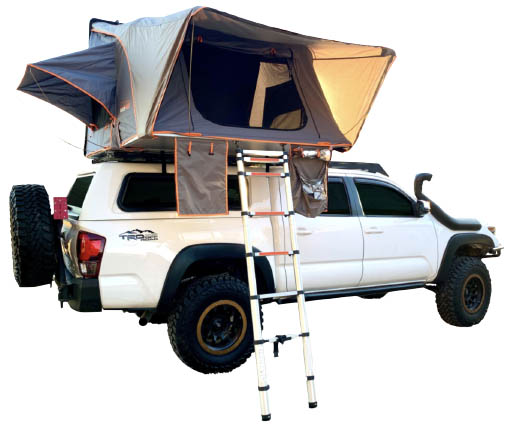 Category: Hardshell
Category: Hardshell
Floor area: 47.8 sq. ft.
Peak height: 50 in.
Capacity: 2+, 3+
What we like: The spaciousness of a softshell tent with the durability and quick set-up of a hardshell.
What we don't: Overkill for solo travelers and most couples.
If you're in the market for a high-end rooftop tent that's built to last, you'll likely settle on a hardshell design. Compared to softshell tents, hardshells are more durable, offer better weather protection, and are easier to set up (we cover more of the differences in our buying advice below). They also give you the versatility of adding a solar panel or roof rack on top, which is worth the added investment for many. Most hardshell tents feature pop-up or clamshell designs that limit the bed to the size of the footprint, but premium fold-out designs like the Condor XL increase sleeping space considerably with an extended platform and mattress (for reference, interior dimensions measure 93 x 74 in., which is larger than a king-size bed and provides ample room for four). Added up, the Condor XL is a stellar combination of performance, interior space, and value, making it our favorite rooftop tent of the year.
iKamper was the original innovator of the fold-out hardshell (see the Skycamp 3.0 below), but Roofnest's take on the concept offers similar quality at a better price. The Condor XL also features a slightly bigger floor area (47.8 sq. ft. vs. 44.3 for the Skycamp), a few additional inches of headroom, and a significantly shorter footprint. To be sure, the Skycamp is a clear contender for our top pick and it's hard to find fault with the highly refined 3.0, but for $500 less the Roofnest is by far the better value. It's worth noting that the Condor is also available in a 2-person version (35.6 sq. ft.; $3,395) and the rugged Condor Overland, which features a durable aluminum shell and accessory channels for transporting axes, shovels, and more. But the XL here is the best all-rounder for couples or small families, and its combination of durability, convenience, comfort, and value is hard to beat.
See the Roofnest Condor XL
Best Softshell Rooftop Tent
2. Thule Tepui Explorer Kukenam 3 ($2,000)
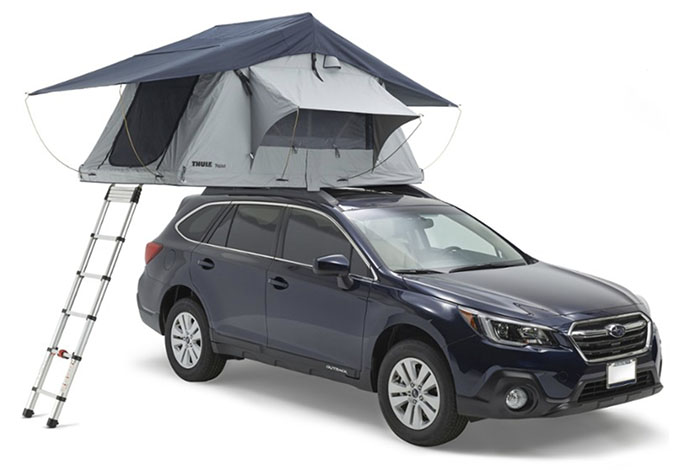 Category: Softshell
Category: Softshell
Floor area: 37.3 sq. ft.
Peak height: 52 in.
Capacity: 3
What we like: Great combination of price, quality, and livability.
What we don't: Hardshell tents offer better weather protection and last longer.
Founded in 2010 and acquired by car-accessory giant Thule in 2018, Tepui offers a well-rounded rooftop tent lineup ranging from affordable entry-level models to burly designs built for overlanding. Their Explorer Kukenam 3 (and two-person Ayer) is their most popular softshell tent and checks all the boxes for most weekend campers, including a standout combination of quality materials, durability, and ease of setup. You get a tough, UV- and mold-resistant 600-denier ripstop body fabric, and water-resistant zippers and a PU-coated rainfly (420D) put up a solid defense against heavy rain and wind. What's more, the Kukenam is reasonably priced, widely available at many retailers (just pop into your local REI Co-op or vehicle accessory store), and pairs seamlessly with Thule racks.
Thule Tepui is a leader when it comes to value, but the rooftop tent competition is stronger than ever in 2022. As we mentioned above, many campers will opt for a hardshell for superior durability, weather protection, convenience, and versatility (for a bump in cost). And stacked up against other softshells, the Explorer Kukenam 3 is a great value, although it does forego bells and whistles like a memory foam mattress, USB charger, and LED light strip (you can always add these after the fact). These small gripes aside, Thule Tepui still is our go-to for long-lasting, reliable rooftop tents that won't break the bank, which is really all most recreational campers need.
See the Thule Tepui Explorer Kukenam 3
Best Budget Rooftop Tent
3. Smittybilt Overlander ($1,137)
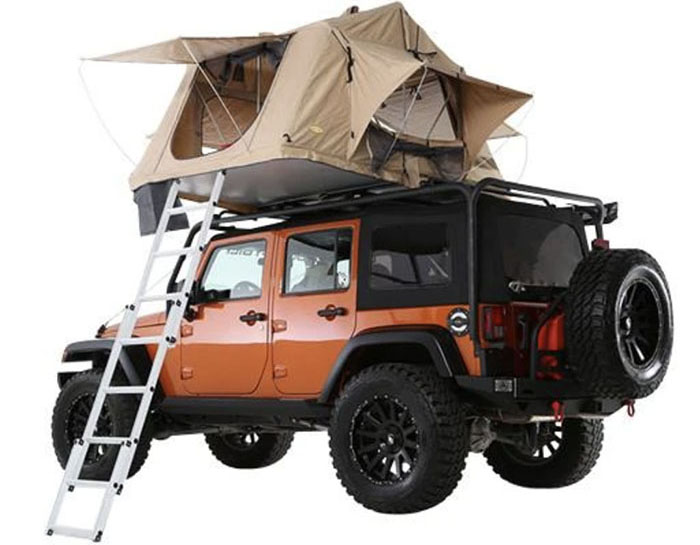 Category: Softshell
Category: Softshell
Floor area:36.9 sq. ft.
Peak height: 51 in.
Capacities: 2+, 3+
What we like: A functional design at a very reasonable price point.
What we don't: Not as user-friendly or durable as the more expensive softshells on this list.
Priced just north of $1,000, the Smittybilt Overlander is one of the best values on the market and our favorite budget-oriented rooftop tent design of 2022. But despite undercutting most of the competition by around half, the Overlander still is a good overall performer: like the Kukenam above, the Smittybilt sleeps two or three campers comfortably, uses heavy-duty materials including a 600-denier ripstop polyester, 420-denier rainfly, and robust zippers and fly poles, and comes with functional features including an integrated LED lighting strip and rubber boot bag to hang your dirty shoes outside the tent. Added up, you'd be hard-pressed to find a more complete design for less money.
That said, you do make some sacrifices by saving with the Smittybilt. For starters, the Overlander's ladder is prone to sticking and difficult to attach—a far cry from the sleek telescoping design you get with models like the Thule Tepui above or CVT Denali below. Second, the storage cover attaches via Velcro rather than a zipper, comes all the way off (most stay attached on one side), and is a bear to get back on (this might seem like a small gripe, but those who move camp daily will notice the extra burden). Finally, installing the Smittybilt is not as straightforward as we'd like and requires some MacGuyvering out of the box. But if you're on a budget and don't mind the added work, the Overlander gets the job done for less than most other softshells. And we should note that Smittybilt now makes the GEN2, which is an updated version of the model included here featuring an improved ladder, a larger rainfly, and a skylight for $1,400. That said, the first-generation tent is still available and a better choice for true budget seekers while supplies last.
See the Smittybilt Overlander
Best Rooftop Tent for Families
4. Cascadia Vehicle Tents Denali Pioneer Extended ($3,095)
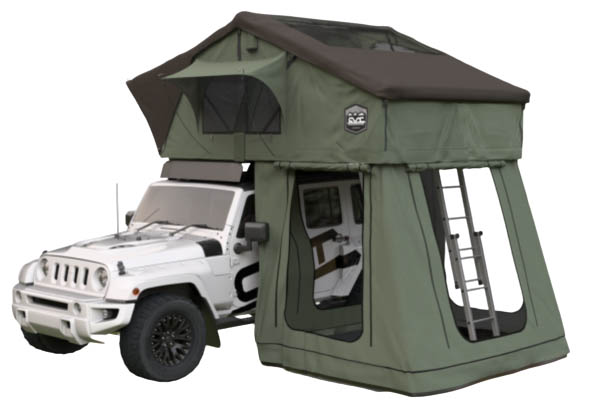 Category: Softshell
Category: Softshell
Floor area:59 sq. ft.
Peak height: 43 in.
Capacities: 2+, 3+, 4+
What we like: Massive interior with a room divider and separate entrances.
What we don't: Very heavy and requires a large vehicle to transport.
Many rooftop tents claim to sleep four, but the CVT Denali is one of few models with the floorplan to back it up. With a generous 59 square feet of padding spread out between two mattresses, you get the equivalent of two double beds, which is ample for two adults and two (or even three) small kids. What's more, the Denali comes with a room divider, two separate entrances (each has its own ladder), and a generous four-door annex. CVT also offers a range of customizations including an insulated cold weather cover, LED light strips, and three few distinct colorways. All in all, for families looking to get outside without sacrificing comfort, the Denali is a very cool and roomy rooftop tent.
The most glaring downsides to the Denali are cost and size. At $3,095 and about 225 pounds, this tent is a behemoth, and you'll likely need a large SUV or truck to tote it around. In terms of competitors, you can save serious cash with the XL version of the Smittybilt above ($1,499), although the sleeping platform is much smaller at around 48 square feet. On the other hand, the 87-inch version of the 23Zero Walkabout below has a similarly large mattress (58 sq. ft) for about $700 less than the Denali. But with a pared-down feature set and no included annex (purchasing it separately will run you about $600), the CVT is the better package deal.
See the CVT Denali Pioneer Extended
Best Rooftop Tent for Small Cars
5. Thule Tepui Low-Pro 2 ($1,750)
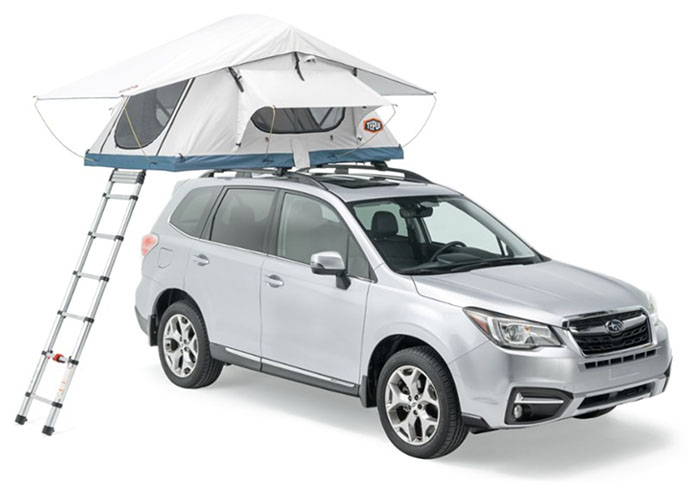 Category: Softshell
Category: Softshell
Floor area:29.2 sq. ft.
Peak height: 44 in.
Capacities: 2, 3
What we like: Lightweight, easy to move, and affordable.
What we don't: Not as spacious as other softshell models.
Thule Tepui's Kukenam 3 above is a spacious and fully featured softshell tent, but for quick trips, smaller cars, and solo travelers, the Low-Pro 2 is a viable and cheaper alternative. The Low-Pro stands apart from other softshell models with a noticeably low-profile and streamlined shape (the version we tested measured only 7 in. tall when packed), and its 105-pound build makes it fairly easy for two people to maneuver. Add in Thule Tepui's reliable build quality, lightweight but durable materials that can withstand winter conditions, and reasonable price tag, and the Low-Pro 2 is a nice choice for those looking for easy rooftop sleeping without the headaches of bad gas mileage or a weighed-down car.
Stacked up against the budget-friendly Smittybilt above, the Low-Pro costs over $500 more and offers significantly less living space (by almost 8 sq. ft.). But Thule Tepui's build quality is superior overall, and most recreational campers will value the simplicity of the Low-Pro over the Smittybilt's more overlanding-focused design. And again, the Low-Pro is lighter and has a much more compact packed size. Other designs in this compact category include the Yakima SkyRise HD Small ($1,899 and 101 lbs.) and Front Runner Roof Top Tent below ($1,169 and 93 lbs.), but these tents don't pack down nearly as small and can be difficult to find locally. And lest you underestimate Thule Tepui's most minimalist model—our testers have endured nights in strong winds, snow, and single-digit temperatures in the Low-Pro and found it to be both stable and protective.
See the Thule Tepui Low-Pro 2
Best Aerodynamic Rooftop Tent
6. Roofnest Falcon 2 ($3,595)
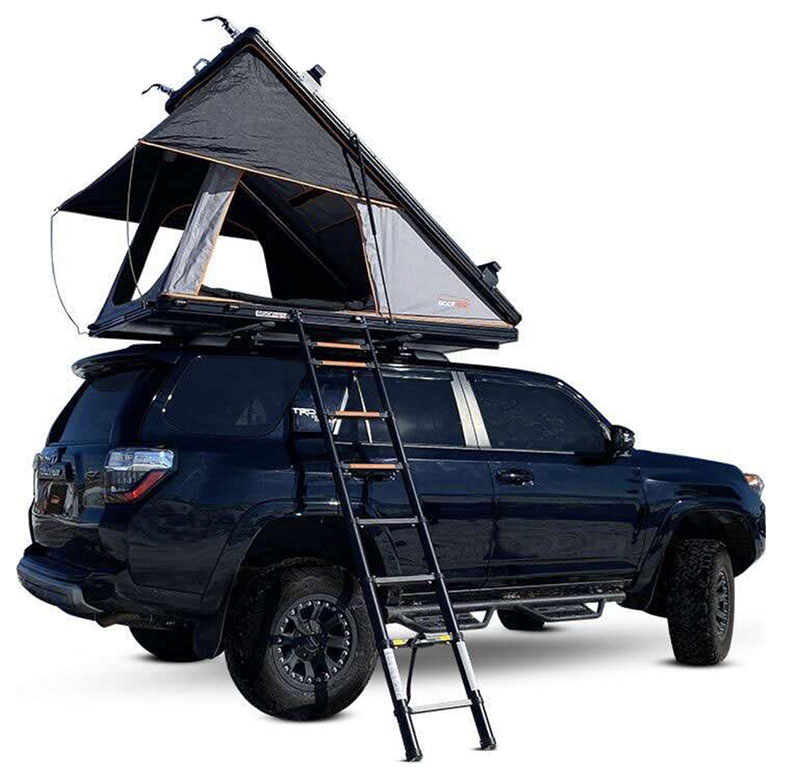 Category: Hardshell
Category: Hardshell
Floor area:28.7 sq. ft.
Peak height: 60 in.
Capacities: 2, 2+
What we like: Durable aluminum shell; low-profile design that accommodates cargo on top.
What we don't: Expensive and too slim to store bedding inside.
At only 6.5 inches tall when closed, Roofnest's Falcon is the slimmest model on our list, undercutting even the aptly named Low-Pro above. This aerodynamic shape will likely have a positive impact on gas mileage and cuts down on wind noise, which can make a big difference in comfort during a long drive. But the low-profile design isn't the only thing we love about this tent: Made with aluminum, the Falcon is Roofnest's most durable design (most hardshells are fiberglass or ABS plastic) and can accommodate a standard roof rack on top, meaning you don't have to choose between your tent and your surfboard, bike, or other external cargo. Finally, despite its slim packed shape, the Falcon opens to a generous 5-foot peak height—the tallest here—and offers great protection from the elements (just be sure to face the shell against the wind). The latest update (the "2") features a more breathable top shell, additional accessory channels along the sides, and upgraded materials in the tent body, but the original formula remains the same.
The biggest drawback to the Falcon's sleek profile is that you can't store your bedding or the ladder inside the tent when packed, which adds a few more steps to the setup and takedown process. But it's nevertheless a svelte and easy-to-use rooftop tent for everything from weekend trips to overlanding, and the durable materials are built to withstand years of use and abuse. If you like the idea of rooftop storage but want the convenience of being able to keep your bedding inside when packed, it's also worth checking out Roofnest's Sparrow Adventure ($3,395), which features a fiberglass shell and a 12-inch packed height. On the other hand, Roofnest's Condor Overland merges the robust aluminum shell of the Falcon with the generous sleeping area of the Condor series. Finally, the Falcon also comes in an XL version that's 10 inches wider ($3,795) and a Pro model ($4,095), which features a secondary tent pole for even more interior space.
See the Roofnest Falcon 2
Best of the Rest
7. iKamper Skycamp 3.0 ($4,199)
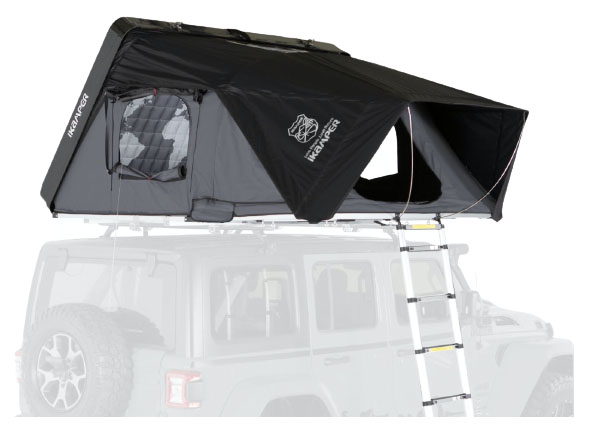 Category: Hardshell
Category: Hardshell
Floor area: 44.3 sq. ft.
Peak height: 48 in.
Capacity: 2, 3-4
What we like: Premium build quality, quick setup, and wind-resistant design.
What we don't: Much pricier than the Roofnest Condor XL above.
iKamper's first-generation Skycamp made waves during its debut in spring of 2017, with a wildly successful Kickstarter campaign that surpassed its $100,000 goal by over $2.2 million. The first fold-out hardshell tent to hit the scene (a design now widely replicated by models like the Roofnest Condor above), the Skycamp became known for its durable construction, large floor plan, and patented 1-minute setup (unheard of for a softshell tent). Now in its third iteration, the 3.0 builds off the original formula with a redesigned mattress and windows, improved materials, and extras like a waterproof electronics port and pole storage. In addition, it also fits bedding inside when closed, which is a big boon for convenience. Added up, the Skycamp is one of the most premium designs here and a solid choice for those looking for the best rooftop tent money can buy.
With all that praise, why do we have the Skycamp 3.0 ranked mid-pack? In short, given that you can get the very comparable Condor XL for over $500 less, we're just not sure the iKamper is worth the investment. What's more, the Roofnest features a larger sleeping area (by about 3.5 sq. ft.) and smaller packed size. But comparisons aside, it's hard to find much real fault with the newest Skycamp, which is about as refined as it gets. And a final note: The Skycamp 3.0 is currently available for pre-order and with shipments scheduled for mid-May, while models of the 2.0 can still be found through iKamper's website for a discounted $3,699. Finally, for solo travelers or couples who don't need the extra-large mattress, the 2-person Skycamp 3.0 Mini will save you some cash at $3,699.
See the iKamper Skycamp 3.0
8. 23ZERO Walkabout 56 ($1,899)
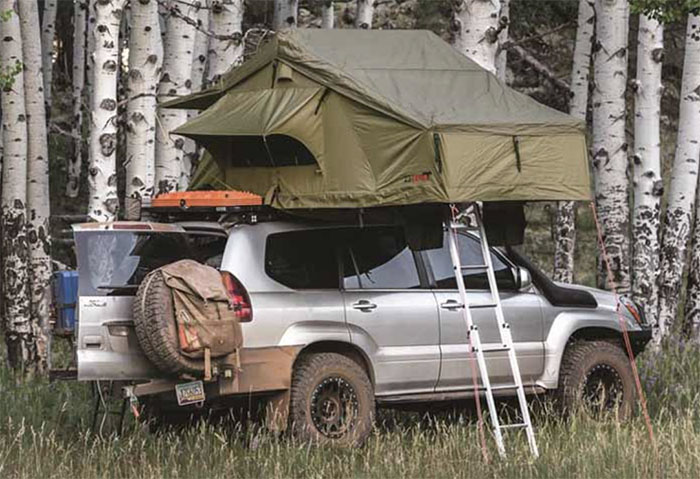 Category: Softshell
Category: Softshell
Floor area:37.3 sq. ft.
Peak height: 49 in.
Capacities: 2+, 3+, 4+, 5+
What we like: Reasonably priced and 4-season-ready.
What we don't: Not everyone will love the utilitarian looks.
While trendy rooftop tents from iKamper, Roofnest, and Thule Tepui appeal to casual campers, brands like 23ZERO and Smittybilt above are popular among the overlanding crowd and prioritize affordability and functionality over convenience and looks. The Walkabout is 23ZERO's top-of-the-line series and comes in four different sizes, ranging from a double bed (the 56 here) to a colossal 87-inch-wide model for larger groups. All models feature comfortable mattresses, light suppression technology that blocks out sunlight (this level of protection is usually only found in hardshells), and weighted doors to reduce flapping in the wind. All told, the Walkabout 56 is a reliable and 4-season-ready rooftop tent that's built to handle just about anything you (or Mother Nature) throw its way.
Stacked up against the budget-friendlier Smittybilt Overlander above, the Walkabout offers a big boost in quality (both the mattress and canvas tent walls are noticeably better in quality), blocks sunlight better, and has a much more bombproof feel in adverse weather. We have the Overlander ranked higher because of its lower price and comparable overall performance, but many—especially those who camp year-round—will find the Walkabout's increased protection and durable construction worth the bump in cost. Keep in mind that 23ZERO does charge extra for shipping ($325 for the 56-inch model), but the Walkabout still is a nice value for what you get.
See the 23ZERO Walkabout 56
9. iKamper X-Cover 2.0 ($3,499)
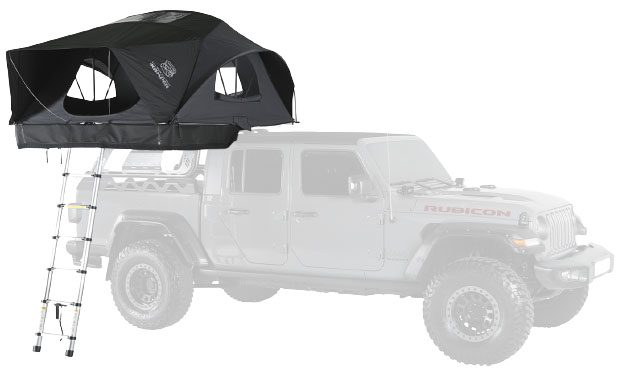 Category: Hardshell/softshell
Category: Hardshell/softshell
Floor area:42.6 sq. ft.
Peak height: 46 in.
Capacity: 2, 3-4
What we like: A well-executed hybrid design that costs and weighs less than the Skycamp above.
What we don't: Takes longer to set up than most hardshells.
The Skycamp 3.0 above is iKamper's tried-and-true hardshell design, but the X-Cover 2.0 merges the performance benefits of a hardtop (including added durability and cargo-carrying capabilities) with the lightweight build and roomy mattress typical of softshells. To accomplish this, the X-Cover forgoes the fabric cover found on traditional softshell models and instead uses its own floor panel to serve as the hard cover, which folds over the tent and protects it when stowed. The result is an easy-to-pitch, versatile design that sleeps three to four people (it's also available in a 2-person "Mini" version). And it doesn't hurt that iKamper has some of the best customer service out there—after a malfunction, one of our testers received a replacement ladder via express mail, and iKamper included a free awning for good measure.
If you're deciding between iKamper's Skycamp 3.0 and the X-Cover 2.0 here, there are a number of key differences to consider. The Skycamp is a true hardshell, and with that comes a quicker setup time and the added stability and weather protection of a fiberglass wall. The X-Cover, on the other hand, is $700 cheaper, 15 pounds lighter, and can carry your bikes, boat, or surfboards on top (keep in mind you'll have to remove all of your cargo before setting up the tent). And with the recent update, the X-Cover 2.0 has many of the same improvements as the Skycamp, including a new mattress and mattress cover, durable zippers, and the ability to leave your bedding inside during transport. Both are functional designs from one of the most respected brands in the business, and a final decision will come down to how you prioritize price, ease of setup, weather protection, and carrying abilities.
See the iKamper X-Cover 2.0
10. Thule Tepui Foothill ($2,000)
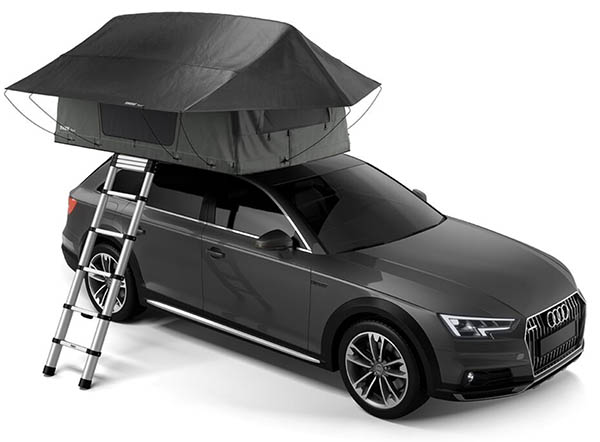 Category: Softshell
Category: Softshell
Floor area: 27.4 sq. ft.
Peak height: 38 in.
Capacity: 2
What we like: Small footprint leaves space for bikes, boats, and other cargo.
What we don't: Limited interior space.
One issue with most rooftop tents is that they're fairly limiting for campers packing large cargo such as bikes, surfboards, or a kayak. New last year, Thule Tepui's Foothill offers a fantastic solution, with a two-person design that packs up to just 24 inches wide, which is about half the size of a typical 2P model. Other tents here—including the iKamper X-Cover, Roofnest Falcon, and AutoHome Maggiolina—accommodate cargo on top of their hard shell (in most cases, you'll have to remove it when setting up the tent), but the Foothill is the first model we know of that leaves space for your standard mounting racks. The end result is a much more sustainable arrangement for those consistently packing extra fun on their rooftop.
Of course, there are inherent compromises in going with such a streamlined design. With a width of just 47 inches, the Foothill's mattress is the narrowest here (the Sparrow is next at 49 in.), and the 38-inch peak height offers middling headroom (keep in mind that it slopes towards the walls too, whereas pop-up models like the Roofnest Sparrow maintain their peak height throughout). But at just 108 pounds and with pre-installed mounting rails, the Foothill is easy to get on and off, and its telescopic design makes for a simple setup. Because of the limited space we don't recommend it for most, but Thule Tepui's Foothill is nothing short of a game changer for adventure junkies and their gear.
See the Thule Tepui Foothill
11. Roofnest Sparrow ($3,195)
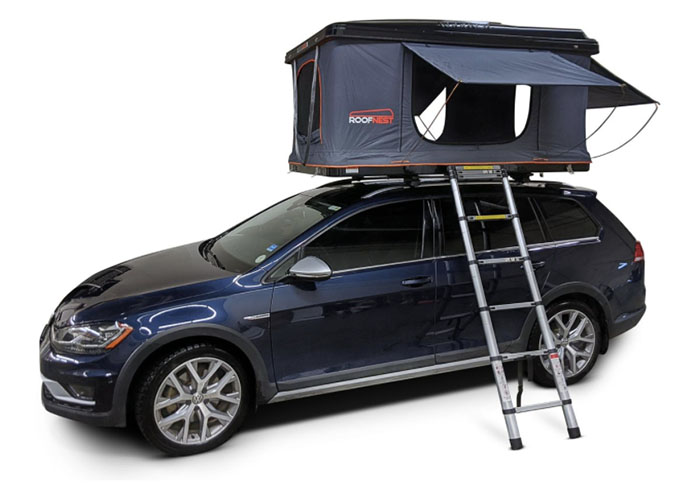 Category: Hardshell
Category: Hardshell
Floor area:28.2 sq. ft.
Peak height: 40 in.
Capacities: 2, 2+
What we like: Easy setup and great headroom.
What we don't: Expensive for its size and not compatible with an annex.
Recently redesigned, the Sparrow is a true testament to Roofnest's high attention to detail. On the outside, the ABS and fiberglass shell is strong, lightweight, and aerodynamic, and unlike a softshell can accommodate a waterproof storage bag (included with the tent purchase) and solar panel. Inside, you get an impressively comfortable, 3-inch-thick mattress (our testers concur) and three full-sized doors with awnings and ladder attachments that offer great livability. The Sparrow is simple to pop open (it can be done by one person in under a minute), and you can even store your bedding inside when you pack the tent up (a notable downside of the Falcon above). All told, Roofnest's two-person pop-up is one of our favorite tents for couples or solo travelers looking to minimize hassle and maximize comfort.
With no annex compatibility and a relatively small floorplan, the Sparrow wouldn't be our first choice for extended outings or basecamping. That said, those who move camp everyday will love the simplicity. Compared to other popular pop-up tents like the AutoHome Maggiolina and James Baroud Evasion below, the Sparrow is considerably more affordable, and you can also remove the canopy and use it as a cargo box when you need extra storage space. Finally, Roofnest also offers the 9-inch wider Sparrow XL ($3,495) and the Sparrow Adventure (available in two sizes) which features a similar design but with the addition of built-in rails and crossbars so you can take all your gear with you (just be mindful of your vehicle's load limit).
See the Roofnest Sparrow
12. Cascadia Vehicle Tents Mt. Hood ($3,495)
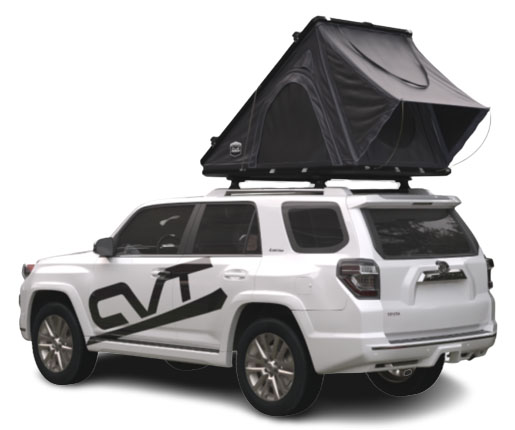 Category: Hardshell
Category: Hardshell
Floor area: 30.2 sq. ft.
Peak height: 55 in.
Capacities: 2, 2+, 3
What we like: Included cross bars and multiple accessory attachment points.
What we don't: Not as aerodynamic as the Roofnest Falcon.
Among hardshell models, it doesn't get much more functional than Cascadia Vehicle Tents' Mt. Hood. Like the Roofnest Falcon above, the Mt. Hood features an aluminum clamshell design that's incredibly easy to set up and offers better wind and rain protection than most softshell or pop-up tents. Inside, you get a plush 3-inch mattress, quilted ceiling liner for extra insulation, and multiple storage pockets. But the outside is where this tent shines: Included cross bars accommodate extra gear like skis or a lightweight boat, while channels around the outside offer attachment points for a shovel, awning, shower, and more. And like all CVT models, the Mt. Hood is built with high-quality materials that hold up well to bumpy roads and night after night of use.
The Mt. Hood comes in three sizes, with the interior footprint ranging from 47 to 57 inches in width (length is standard at 82 in.). The Roofnest Falcon 2 is a better choice for taller campers with 4 more inches from head to toe and 5 inches more at the peak height (55 vs. 60 in.), but the size medium Mt. Hood is $100 cheaper, including the cross bars (you'll have to purchase these separately from Roofnest, to the tune of $195). And while the CVT isn't nearly as aerodynamic as the Falcon 2 (11 vs. 6.5 in. packed heights), the good news is that it can accommodate bedding when packed up, making setup and takedown that much easier. Clamshells aren't as livable or versatile as most rooftop tent designs, but for no-frills convenience and 4-season protection, the Mt. Hood is a great value and well worth a look.
See the Cascadia Vehicle Tents Mt. Hood
13. AutoHome Maggiolina AirLand Plus Medium ($4,299)
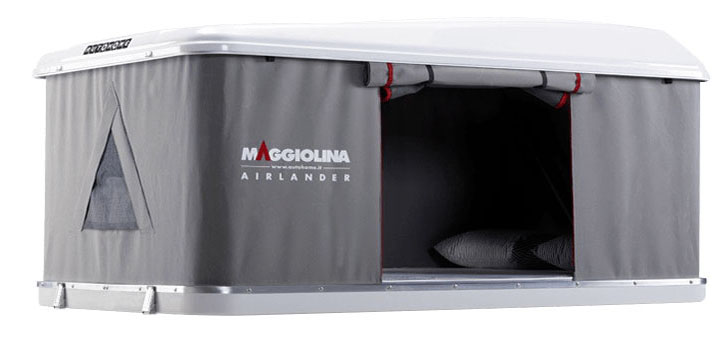 Category: Hardshell
Category: Hardshell
Floor area:27 sq. ft.
Peak height: 36 in.
Capacities: 2, 2+, 3, 3+, 4
What we like: Built to last and the hand crank is strong and dependable.
What we don't: Not very spacious and no awnings or full-zip doors.
Made in Italy and distributed throughout the U.S. by AutoHome USA, Maggiolina tents are known for their simple yet durable designs. The medium-sized AirLand Plus is our favorite model in their lineup for its cushy, 3.5-inch foam mattress, sturdy ladder, and simple pop-top design. And unlike the automatic gas struts on hardshells tents from iKamper and Roofnest, the Maggiolina opens with a hand crank, which is a noticeably beefier system and can be operated even with cargo or heavy snow on top. It takes a bit more time and effort, but we like the simplicity and find the manual lift to be more reliable overall (you also can opt for AutoHome's Air Top, which adds a gas-strut-assisted opening to the Maggiolina's design).
Why do we have the AirLand ranked here? Compared to the Roofnest Sparrow above, the Maggiolina offers slightly less real estate for your money: with the Sparrow XL, you get almost 7 extra square feet and 4 inches more headroom for around the same price as the medium AirLand here. Further, the Roofnest's awnings and full-zip doors offer a big boost in protection from the elements (the Maggiolina doesn't come with awnings and its doors only zip on the sides). But these complaints aside, the AirLand Plus is a simple yet rugged rooftop tent with minimal breakable parts, earning it a spot on our list.
See the AutoHome Maggiolina AirLand Plus Medium
14. Yakima SkyRise HD 2 ($1,899)
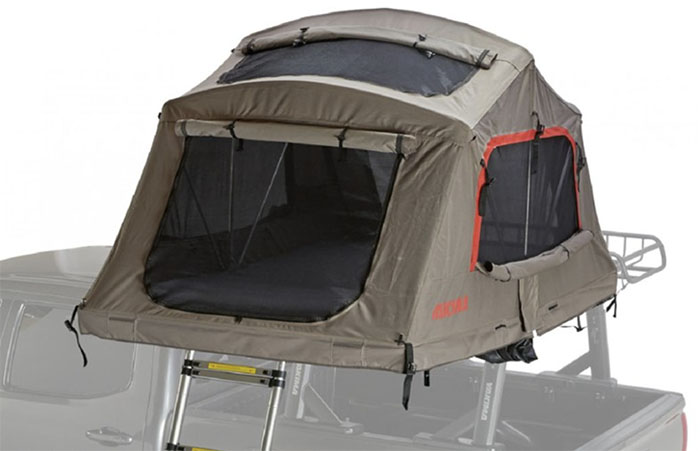 Category: Softshell
Category: Softshell
Floor area: 28 sq. ft.
Peak height: 42 in.
Capacities: 2, 3
What we like: Great headroom, rooftop window, and tool-free installation.
What we don't: Pricier than the Kukenam with less interior space.
Yakima is best known for their extensive collection of high-quality roof racks and car accessories, and their SkyRise HD harnesses that manufacturing expertise in a well-executed rooftop tent design. The SkyRise comfortably sleeps two (or bump up to the medium for three) and offers more headroom than most softshells with a wide ceiling and steep sidewalls. Other perks include durable and PU-coated fabrics (including a 600D polyester body and 210D fly), D-rings and guylines to attach gear or secure the tent in a squall, and a clear vinyl "skylight" in the fly, which is a nice touch for letting in light when conditions take a turn.
The SkyRise HD takes direct aim at our top softshell pick, the Tepui Kukenam above. Comparing the three-person models, the Kukenam is $400 cheaper at $2,000 (the SkyRise HD 3 is $2,399) and features a 4-inch-taller peak height at 52 inches. However, the Yakima weighs around 16 pounds less, and we also like the larger doors and windows, which open up the interior in a big way. For strictly summer use, Yakima also makes the standard SkyRise (no "HD"), which uses thinner materials and is priced at an affordable $1,899 for the 3-person design (medium). And a final bonus: all versions of the SkyRise come with tool-free installation, which makes the mounting process relatively quick and painless.
See the Yakima SkyRise HD 2
15. Freespirit Recreation High Country 55" ($2,395)
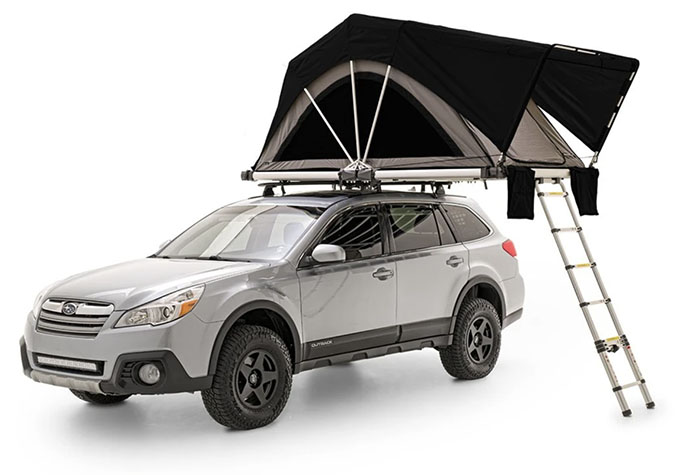 Category: Softshell
Category: Softshell
Floor area:37.4 sq. ft.
Peak height: 46 in.
Capacities: 2+, 3+, 4+
What we like: Quality build and quick setup for a softshell.
What we don't: Expensive and only one window awning.
Bend, Oregon-based Freespirit Recreation is a cottage brand in the world of rooftop tents, but their lineup is impressive and deserves a serious look. They offer three different styles, including a clamshell hardtop (the Odyssey), a pop-up softshell (their Adventure series), and a fold-out softshell (the High Country included here). The High Country 55" is a durable option for two campers, with 4 inches of padding between the 2-inch floor and 2-inch mattress, oversized windows for open viewing, and an incredibly fast setup time. Stepping up to the "premium" version for $300 more will get you LED lights and thicker walls for 4-season use, but the standard model here strikes us as the better value. All in all, these tents might be pricey, but they're extremely well built and competitive with the likes of premium offerings from CVT, iKamper, and Roofnest.
As we touched on above, the High Country comes with large windows all around, but unfortunately it only has one awning, meaning you'll have to button up the exposed sides in the rain (the Thule Tepui Kukenam, for comparison, has awnings at each window and door). And at 14 inches tall when packed, the High Country isn't a great choice for those worried about gas mileage. These nitpicks and the tent's lack of standout features push it down our list, but Freespirit's quality and attention to detail are top-notch.
See the Freespirit Recreation High Country 55"
16. Tuff Stuff Ranger 3 ($1,549)
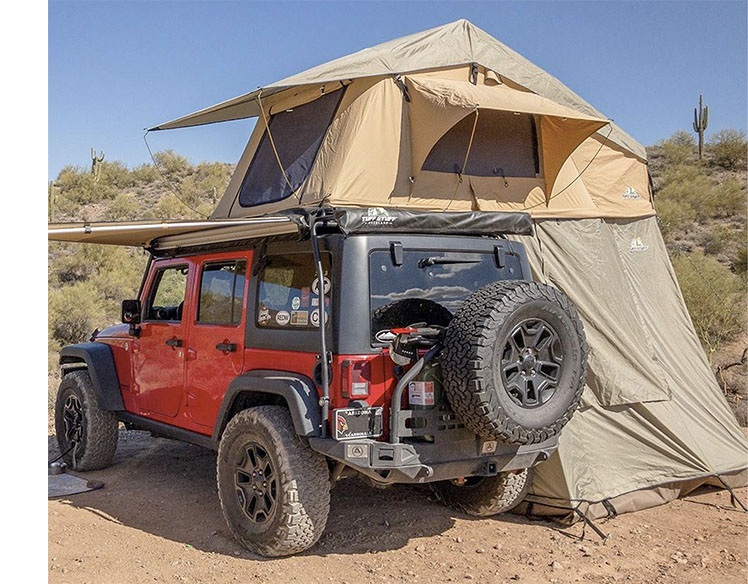 Category: Softshell
Category: Softshell
Floor area:37.3 sq. ft.
Peak height: 52 in.
Capacity: 3
What we like: Annex and installation tools included in purchase.
What we don't: Lacks the fit and finish of a Thule Tepui model.
Buying a rooftop tent is only the first step in kitting out your vehicle—you'll also need tools for installation, and many people add accessories like annexes and gear lofts later on. Tuff Stuff essentially is a one-stop shop, and their Ranger 3 comes stock with all the necessary assembly and mounting tools, a hanging gear hammock, and even a storage bag for your shoes. At just $1,549 (tack on the annex for $296 more), that's a fairly good deal for a 3-person tent, and we think of the Ranger as a great starter option for those who want to hit the road without all the hassle of buying parts and add-ons separately.
All that said, the Tuff Stuff doesn't have the same polished and premium feel you get from Thule Tepui's softshells, nor does it come with the same range of customizations. In the end, you get what you pay for: Tepui's singular focus is rooftop tents, and they have a major leg up in quality. But Tuff Stuff is no slouch, and their overlanding products—which range from trailers to winches and truck bed racks—are great values. In the end, the Ranger 3 strikes a nice balance of functionality and affordability, which earns it a spot on our list. Tuff Stuff also offers a number of other softshell, clamshell, and fold-out hardshell options, from the two-person Delta ($1,499) to the four-person Alpha.
See the Tuff Stuff Ranger 3
17. Thule Basin ($3,250)
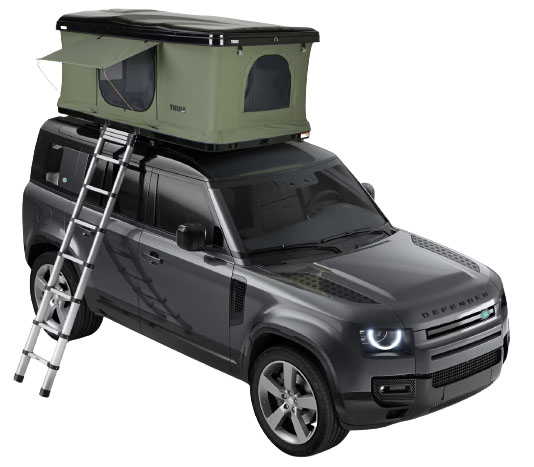 Category: Hardshell
Category: Hardshell
Floor area: 28.7 sq. ft.
Peak height: 37 in.
Capacity: 2
What we like: Rooftop tent and cargo box in one.
What we don't: Heavier and more expensive than the Roofnest Sparrow above.
Thule's Basin is a hybrid design that is part rooftop tent, part cargo box. With the tent canopy installed, pop up the roof and you have a snug sleeping area for two, complete with a plush, 3-inch foam mattress and well-ventilated yet waterproof walls. When you need added storage space, unzip the canopy, take out the mattress, and use the Basin as a rugged rooftop gear tote to stash your skis or camping equipment (in this configuration, it opens up in a clamshell shape and features 23 cubic feet of storage). If you're considering a rooftop tent but also value cargo space, the Basin is a nice compromise.
That said, the Basin undoubtedly is expensive, especially considering you can pick up the iKamper X-Cover above for just a few hundred dollars more, which features almost 20 square feet more space inside along with the ability to shuttle rack-mounted gear on top. Further, while Roofnest doesn't market its Sparrow above as a cargo box, its tent walls also can be unzipped to achieve the same dual functionality (plus, it's 45 pounds lighter, over $50 less, and has 3 inches more headroom). But for a well-built product from a trusted brand, the Basin fits the bill as another solid multi-purpose option. And Thule also offers the Basin in a "Wedge" version, which is similar to the model here but only opens in a clamshell configuration.
See the Thule Basin
18. James Baroud Evasion ($4,481)
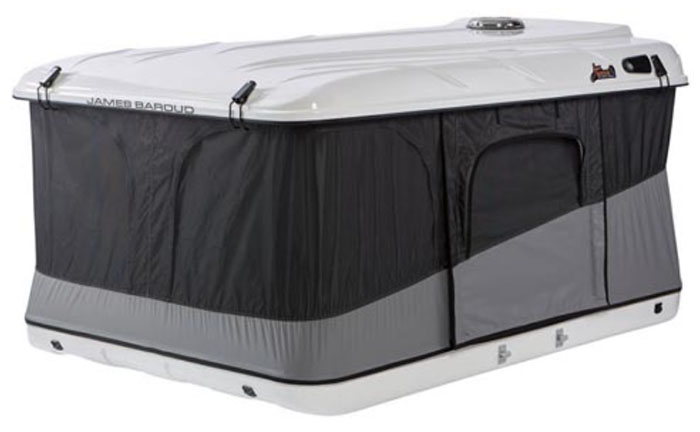 Category: Hardshell
Category: Hardshell
Floor area:29.8 sq. ft.
Peak height: 41 in.
Capacities: 2, 3
What we like: Insanely high quality and premium feature set, including a solar-powered fan.
What we don't: Expensive.
If you're looking for the Mercedes Benz of rooftop tents, James Baroud is your answer. For over 30 years, this Portugal-based company has designed and produced rooftop tents that top the charts in terms of comfort, stability and bombproof weather protection, and quality design. With standard features including a solar-powered ventilation fan, gas-strut assisted opening (setup takes 30 seconds), and LED lighting, even James Baroud's base models are a cut above the rest.
The James Baroud Evasion is a pop-top hardshell, similar to models like the Roofnest Sparrow above and Maggiolina AirLand below. You'll pay a pretty penny for this tent, but it's more suitable for the rigors of overlanding than most—all James Baroud models are made with the highest quality materials and are tested in 60 mph winds (unlike most hardshell tents, they're also compatible with an enclosed awning). Most rooftop campers can get away with a cheaper tent (or pay a similar price for a roomier model), but for brand-name bragging rights and the classiest tent on the block, you simply can't beat James Baroud. These tents can be hard to find (James Baroud sells through their website and through a few other retailers), but it doesn't hurt that they all come with a reliable 5-year warranty.
See the James Baroud Evasion
19. Front Runner Roof Top Tent ($1,169)
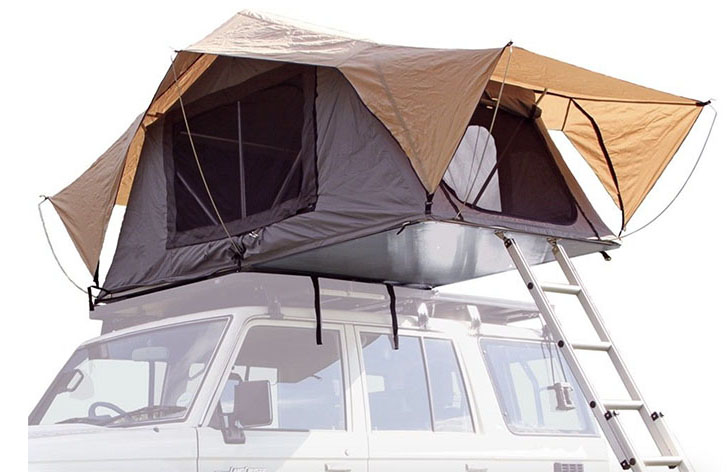 Category: Softshell
Category: Softshell
Floor area:34 sq. ft.
Peak height: 46 in.
Capacity: 2+
What we like: Time-tested along South Africa's rugged back roads; lightweight and easy to move.
What we don't: Lacks the premium feel of the Thule Tepui Low-Pro above.
Off-roading is incredibly popular in South Africa, and therefore it comes as little surprise that Johannesburg-based Front Runner is well-respected for their thoughtfully designed and robust overlanding products. Their 93-pound Roof Top Tent (formerly the Featherlight) is the lightest model on this list and a nice option for smaller cars, solo travelers, or those who plan to take their tent off their vehicle between trips. To make the loading and unloading processes even easier, Front Runner also sells their Quick Release Tent Mount Kit for an additional $213, which allows you to remove the tent quickly and without tools (it can also be paired with most other models here).
Despite its low weight, the Front Runner retains a durable body fabric (600D poly/cotton ripstop) and rainfly (400D polyester oxford), along with a reliable base and frame. Compared to the similarly intentioned Thule Tepui Low-Pro 2 above, the Front Runner is 12 pounds lighter and costs over $400 less, but it's significantly taller when packed (13 vs. 7 in.), and the sliding (rather than telescoping) ladder and thin mattress lack the premium feel of the Thule Tepui. These gripes land it a bottom-of-the-pack finish, but it's still a lightweight and functional rooftop design at a good price.
See the Front Runner Roof Top Tent
Rooftop Tent Comparison Table
| Rooftop Tent | Price | Category | Floor | Peak Height | Weight | Capacities | Annex |
|---|---|---|---|---|---|---|---|
| Roofnest Condor XL | $3,695 | Hardshell | 47.8 sq. ft. | 50 in. | 160 lbs. | 2+, 3+ | Sold separately |
| Tepui Explorer Kukenam 3 | $2,000 | Softshell | 37.3 sq. ft. | 52 in. | 131 lbs. | 3 | Sold separately |
| Smittybilt Overlander | $1,137 | Softshell | 36.9 sq. ft. | 51 in. | 117 lbs. | 2+, 3+ | Sold separately |
| CVT Denali Pioneer Extended | $3,095 | Softshell | 59 sq. ft. | 43 in. | 225 lbs. | 2+,3+,4+ | Included |
| Thule Tepui Low-Pro 2 | $1,750 | Softshell | 29.2 sq. ft. | 44 in. | 105 lbs. | 2, 3 | Sold separately |
| Roofnest Falcon 2 | $3,595 | Hardshell | 29.3 sq. ft. | 60 in. | 140 lbs. | 2, 2+ | Not compatible |
| iKamper Skycamp 3.0 | $4,199 | Hardshell | 44.3 sq. ft. | 48 in. | 165 lbs. | 2, 3-4 | Sold separately |
| 23ZERO Walkabout 56 | $1,899 | Softshell | 37.3 sq. ft. | 49 in. | 130 lbs. | 2+,3+,4+,5+ | Sold separately |
| iKamper X-Cover 2.0 | $3,499 | Softshell/ hardshell | 42.6 sq. ft. | 46 in. | 150 lbs. | 2, 3-4 | Sold separately |
| Thule Tepui Foothill | $2,000 | Softshell | 27.4 sq. ft. | 38 in. | 108 lbs. | 2 | Not compatible |
| Roofnest Sparrow | $3,195 | Hardshell | 28.2 sq. ft. | 40 in. | 130 lbs. | 2, 2+ | Not compatible |
| CVT Mt. Hood | $3,495 | Hardshell | 30.2 sq. ft. | 55 in. | 193 lbs. | 2, 2+, 3 | Not compatible |
| Maggiolina AirLand Plus | $4,299 | Hardshell | 27 sq. ft. | 36 in. | 132 lbs. | 2,2+,3,3+,4 | Not compatible |
| Yakima SkyRise HD 2 | $1,899 | Softshell | 28 sq. ft. | 42 in. | 101 lbs. | 2, 3 | Sold separately |
| FSR High Country 55" | $2,395 | Softshell | 37.4 sq. ft. | 46 in. | 141 lbs. | 2+,3+,4+ | Sold separately |
| Tuff Stuff Ranger 3 | $1,549 | Softshell | 37.3 sq. ft. | 52. in. | 154 lbs. | 3 | Sold separately |
| Thule Basin | $3,250 | Hardshell | 28.7 sq. ft. | 37 in. | 176 lbs. | 2 | Not compatible |
| James Baroud Evasion | $4,481 | Hardshell | 29.8 sq. ft. | 41 in. | 145 lbs. | 2, 3 | Sold separately |
| Front Runner Roof Top Tent | $1,169 | Softshell | 34 sq. ft. | 46 in. | 93 lbs. | 2+ | Sold separately |
Rooftop Tent Buying Advice
- Rooftop Tents: Softshell vs. Hardshell
- Rooftop Tent Capacities
- Interior Space: Mattress Dimensions and Peak Height
- Weather Resistance and Insulation
- Set up and Take Down
- Closed Size and Aerodynamics
- Annexes and Awnings
- Vehicle and Rack Compatibility
- Installing a Rooftop Tent
- Purchasing a Rooftop Tent Online
- Is a Rooftop Tent Right for You?
Rooftop Tents: Softshell vs. Hardshell
Softshell Tents
Most first-time rooftop tent shoppers opt for softshell models, and for good reason. These tents are covered with a burly waterproof soft cover and fold out beyond the roof of your vehicle. The tent body (usually made of canvas or nylon) is attached to the entire platform and sets up with the help of internal hinges and manually placed poles. The most obvious advantage here is price: two-person softshells usually fall between $1,000 to $2,000, whereas a standard two-person hardshell tent will run you north of $3,000. Softshell tents also feature larger floor plans, come in a variety of shapes, and can easily accommodate annexes and awnings (more on this below).
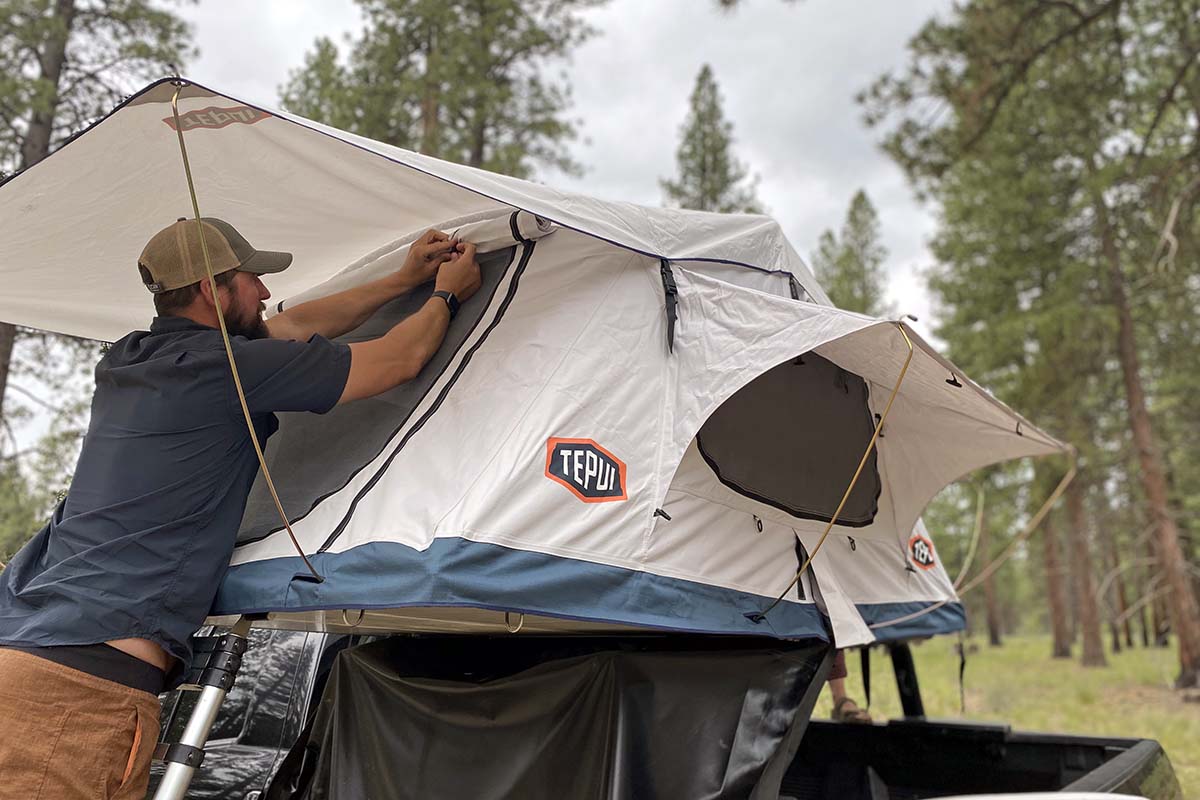
However, when held up against hardshell models, the downsides are clear. First and foremost, the soft coverings are much more prone to moisture buildup (read: mold) when stored, resulting in a shorter lifespan. Additionally, without the stability of a hard cover, softshell tents are often noisier in the wind, both when opened and packed away. Finally, expect a softshell to take significantly longer to set up and take down, similar to a ground tent (most hardshells pop right up once you release the locks or latches).
Hardshell Tents
Rather than using a soft cover, hardshell tents consist of a fiberglass, plastic, or aluminum shell that houses the fabric tent canopy inside. Most open either on a hinge (clamshells) or pop up on all sides (like a box). The majority of hardshells keep their footprint to the vehicle's roof area, but a few (like the Roofnest Condor XL) fold out, increasing the floor area and allowing you to add on extras like an awning.
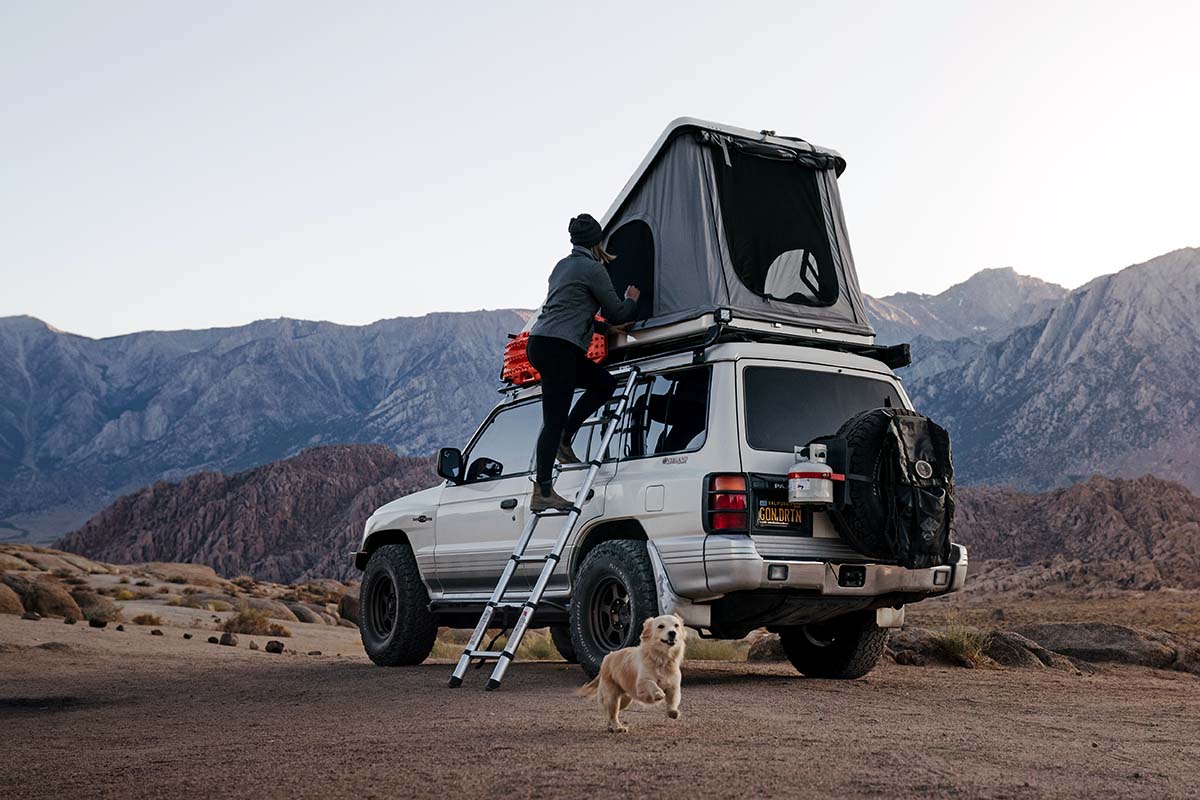
Hardshell tents are significantly more expensive and heavier than softshells, and many feature smaller floorplans. However, their longer lifespan, added convenience, and superior protection are well worth it for many. During transport, hardshell tents also are more aerodynamic, completely waterproof (mold is less of a concern), and protective against low-hanging branches and flying debris. Further, their shell-like design means they can often fit extra items like bedding inside, and some (like the iKamper X-Cover 2.0) can even accommodate a bike, skis, kayak, surfboard, or solar panel on top. When open, they're far more resistant to wind, typically have more headroom, and are known for plusher mattresses. And one of the biggest draws to hardshell tents is ease of setup, which often can be done by one person in under a minute. For campers who pack up and move camp every day, this is a big plus.
Rooftop Tent Capacities
Like traditional camping and backpacking tents, rooftop tents come in a variety of capacities, from minimalist two-person models to massive designs that can accommodate up to six. The manufacturer's recommended capacity is a good place to start, but take note: these specs are often rather generous. For example, Roofnest's Sparrow is 5 inches narrower than a double mattress, and the iKamper Skycamp 3.0's mattress—listed as suitable for four people—is just a little bigger than a standard king-sized mattress. In the end, families with young children likely can get away with smaller floorplans, but many campers will choose to size up or opt for XL versions (an option with Roofnest's tents). In our experience, the added comfort and livability are almost always worth the bump in price.
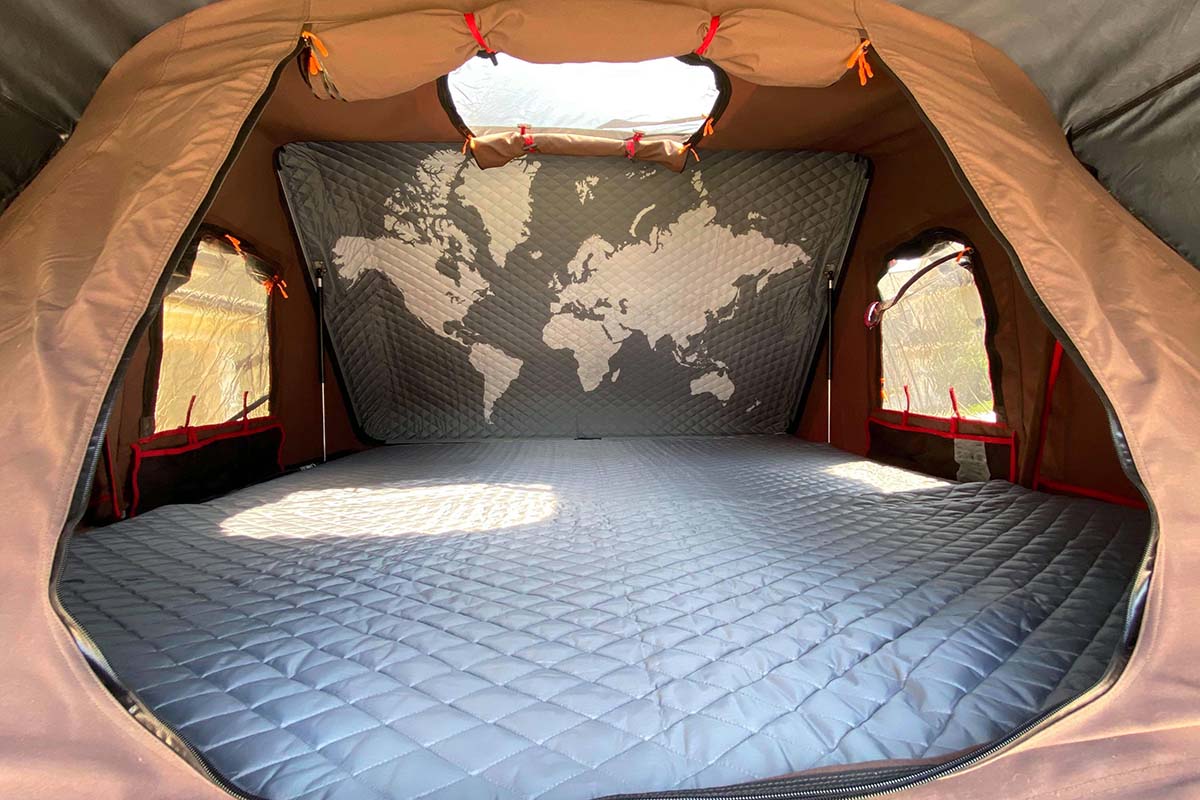
Interior Space: Mattress Dimensions and Peak Height
As we touched on above, a tent's listed capacity and interior dimensions don't always line up perfectly. Among the tents here, mattress dimensions range from 47 by 84 inches (slightly narrower than a double mattress) to 87 by 96 (larger than a king-size mattress), with peak heights from 36 (AutoHome's Maggiolina AirLand) to 60 inches for the Roofnest Falcon 2. And keep in mind that a tent's floor dimensions are not always the same as the size of the mattress. CVT's extended fly series, for example, features a larger floorplan, but the mattress dimensions are the same as what you get in the standard fly models. Finally, remember that peak height only specifies the highest point in the tent—box-like hardshells like the Roofnest Sparrow have a tall peak height throughout, while others, including clamshells and softshells, slope downwards from the highest point.
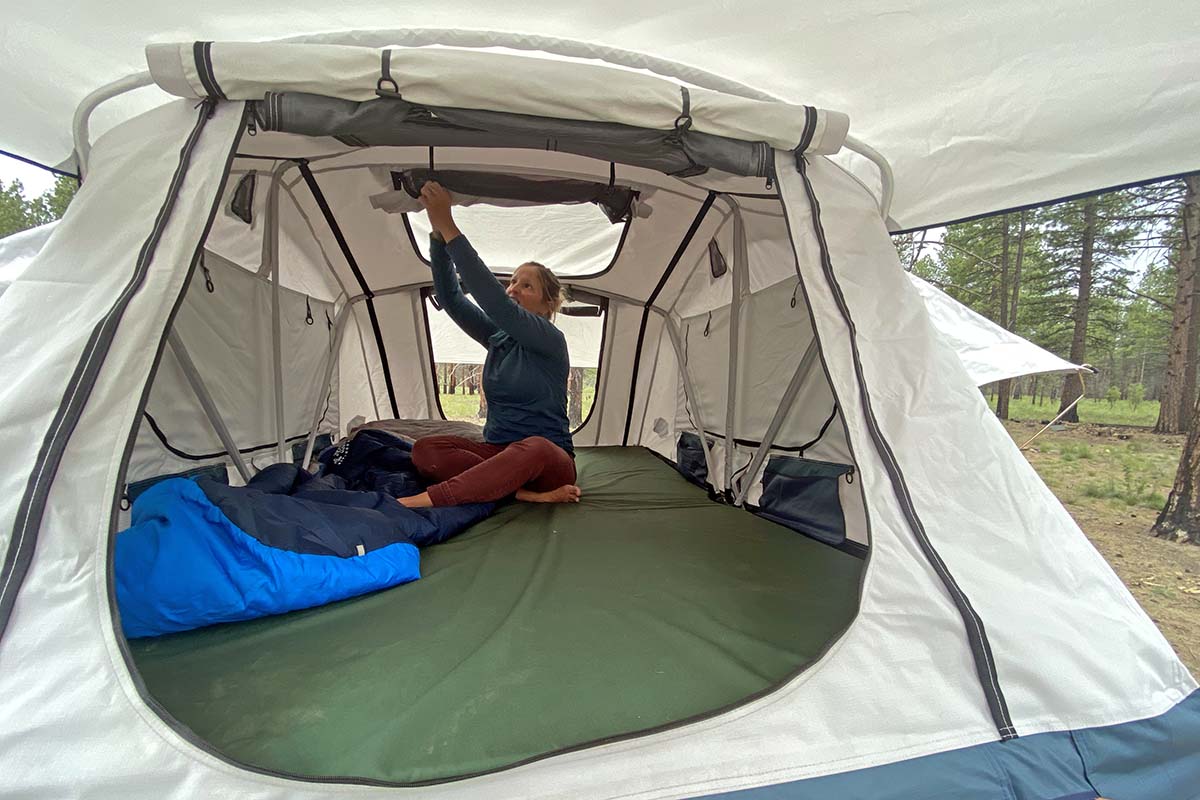
Integrated Mattresses and Comfort
A key design feature and one of the biggest draws to rooftop tents is the integrated mattress, which run the gamut from relatively thin 1.8-inch pads to plush 3.5-inch memory-foam-topped beds. In determining comfort, you'll want to look at the depth along with additions like a memory or gel foam topper, keeping in mind that clamshell or pop-top hardshell tents generally have the most premium options (they don't have to fold to close up). Roofnest tents, for example, are known for comfort, whereas the budget-oriented Smittybilt Overlander's mattress is thin and stiff. Finally, keep in mind that some manufacturers offer mattresses upgrades: Thule Tepui's standard mattress is 2.5 inches thick, while their Siesta Luxury Mattress features 3 inches of foam along with an anti-condensation mat.
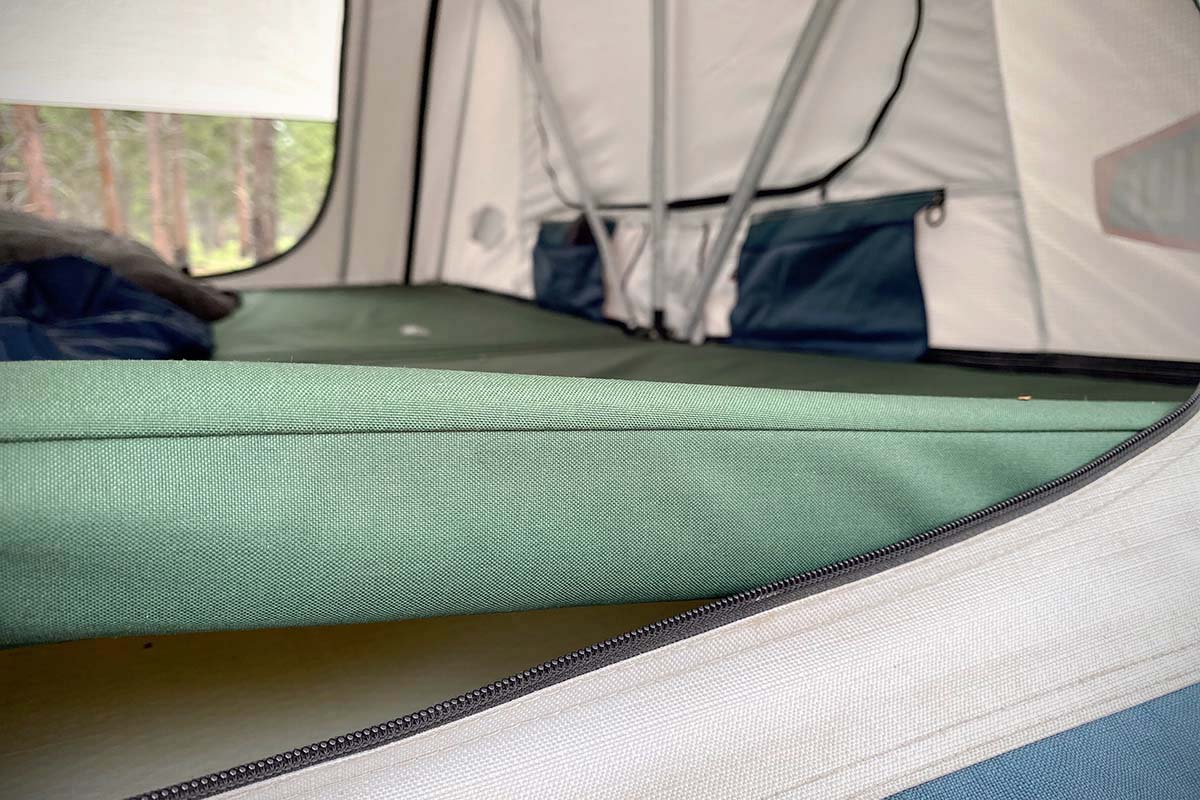
In addition to mattress thickness and type, you'll also want to consider a mattress cover and anti-condensation mat. Most mattresses come with removable covers for easy laundering, which vary in terms of water resistance, breathability, and comfort. In our opinion, your best bet is to opt for a protective cover (waterproof/breathable) and supplement with a sheet set (brands like Thule Tepui sell custom-sized sheets or you can make do with a standard bed sheet set). Further, many tent designs incorporate an anti-condensation mat underneath the mattress to mitigate moisture buildup and mold (these can also be purchased separately). That said, it's always a good idea to remove your mattress between trips or prop it up on its end during the day to dry out the underside and allow it to breathe.
Weather Resistance and Insulation
Rooftop tents are built to withstand the elements, with thick, water-resistant body fabrics (usually a polyester cotton blend) and fully waterproof rainflys. If you plan to use your tent in inclement conditions, be sure to look for full-coverage awnings on all the windows and doors so you can keep air flowing without allowing moisture in. Pop-top and clamshell models like the James Baroud Evasion and CVT Mt. Hood use their shells as roofs, with clamshells providing the strongest structure (as long as you park with the shell towards the direction of the wind) and a quieter sleep in blustery conditions. In fact, one of our testers upgraded to a hardshell because he'd grown so tired of his softshell flapping in the wind.
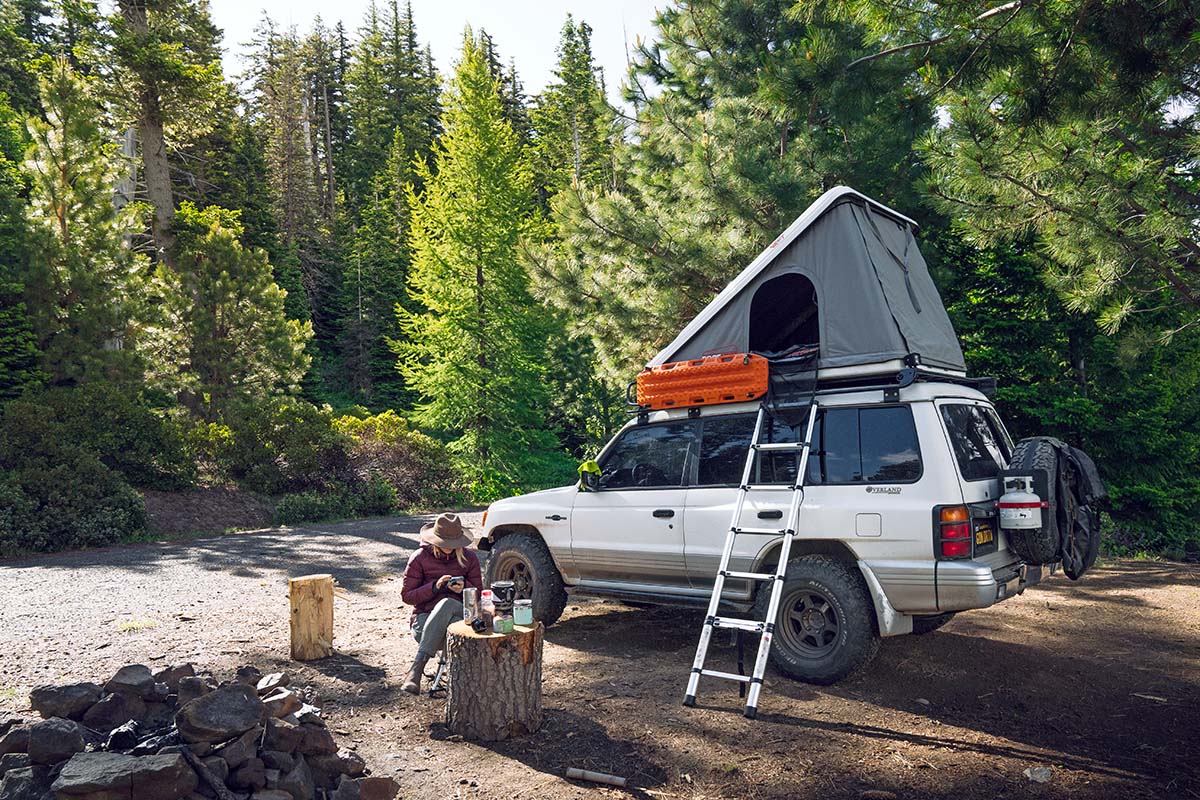
In addition to protection against wind and rain, some rooftop tents come with the option to add extra insulation, like iKamper's Inner Insulation Tent and the Thule Tepui Insulator. If you're used to sleeping outside, have a warm sleeping bag, or plan to camp only in the summer months, additional insulation probably isn't necessary. But for those get outside year-round or frequently sleep at elevation, these inserts can add a nice dose of warmth on cold nights.
Ventilation
In general, rooftop tents are great breathers. First, because air flows underneath the body between the tent and your vehicle, by nature they ventilate better than standard ground tents. Second, most models come with generous windows and mesh panels, many of which can be completely unzipped or closed with just a bug net and are protected by waterproof awnings. Additionally, manufacturers often add anti-condensation mats underneath a hardshell's roof or under the mattress, minimizing pesky drips in the middle of the night and mold buildup (these also add another layer of insulation).
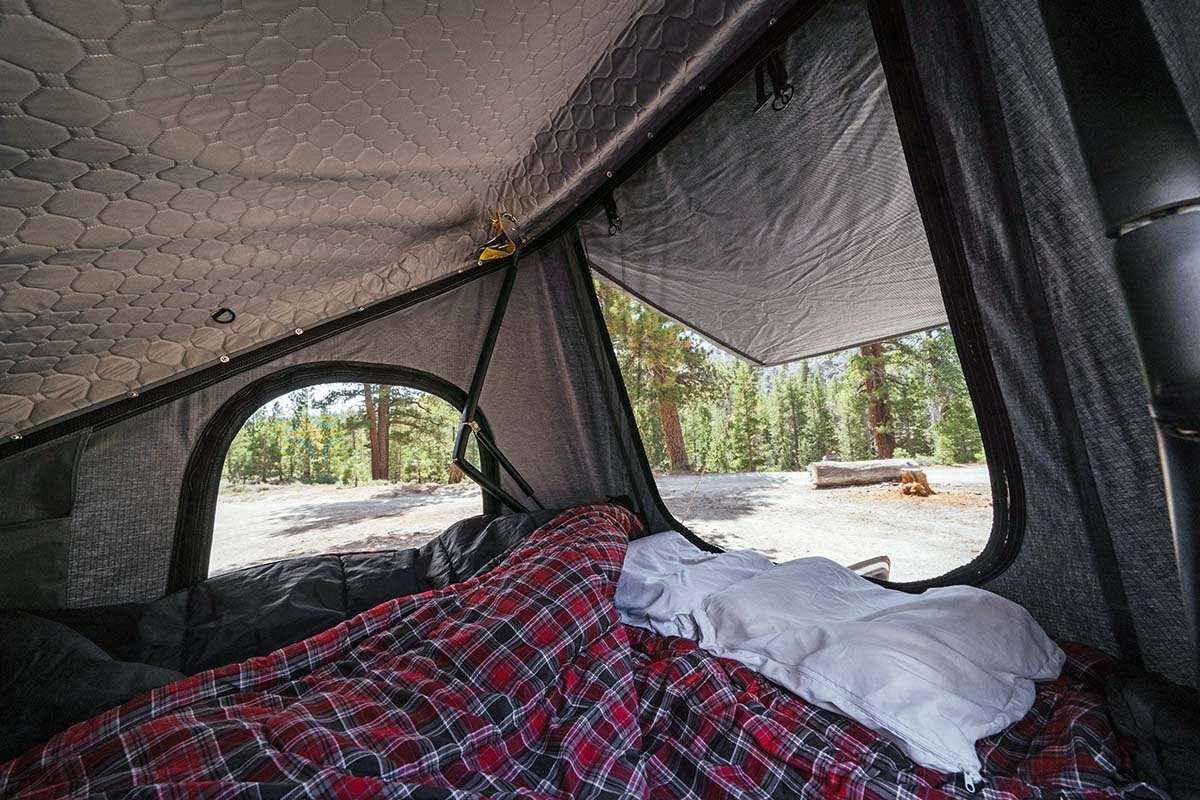
If ventilation is a top priority, we recommend looking for a tent with a breathable body fabric, full-coverage rainfly (or insulated hard top), and enough space between the two for air to flow. We love iKamper's tents, but many users complain that they don't vent well due to the lack of space between the body and fly (you can always roll back the fly on dry nights). Regardless of which tent you choose, it's best to sleep with the windows and vents open to encourage airflow and minimize the accumulation of condensation overnight.
Set up and Take Down
In general, rooftop tents are far more convenient to set up than pitching a standard ground tent. However, there are some key differences between models. Hardshell tents are the speediest to assemble—it's often as simple as unclipping the shell, engaging the hinges, and watching the roof rise. Even a more complex hardshell like the iKamper Skycamp 3.0 can be set up in a minute. On the other hand, softshell tents require a bit more time to remove the soft cover and insert poles to prop up the fly and awnings. Take down is just a matter of reversing the steps, although you'll want to be careful to ensure that all of the tent fabric is safely inside the shell or cover.
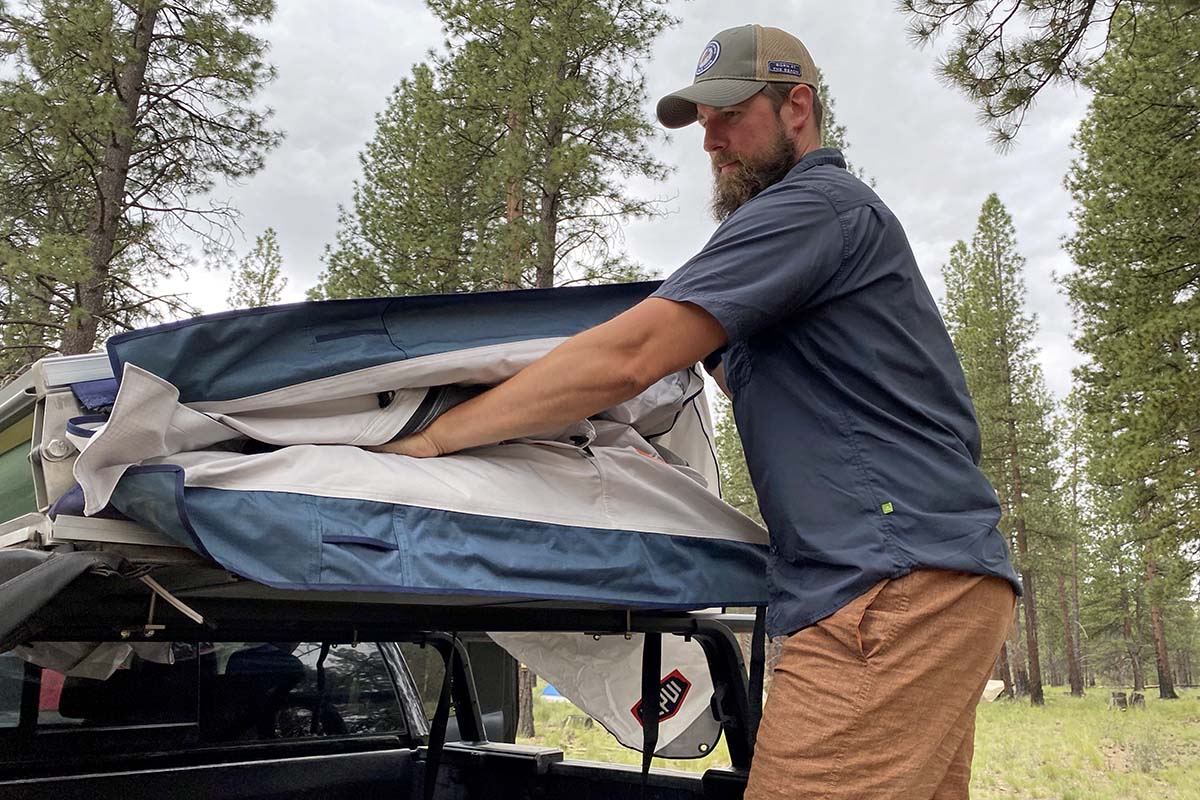
Recreational campers or those who plan to use their rooftop tent only occasionally may not be bothered by the extra time it takes to set up and take down a softshell tent. However, frequent travelers and avid overlanders (especially those who pack up and move camp daily) will appreciate the convenience of a hardshell's easier setup. A few minutes might not seem like much, but it adds up quickly. And if you're adding an annex or separate awning (see our section on "Annexes and Awnings" below), it goes without saying that your setup will take longer and be more involved. In general, these are great systems for those who plan to stay parked for two or more nights, but we don't recommend them for campers who pack up and move each day.
Closed Size, Aerodynamics, and Gas Mileage
Packed sizes of rooftop tents varies widely, but it's a good rule of thumb to keep the footprint of your tent within your roof's dimensions—and those with small cars or trucks should be especially careful before making a purchase. Packed height also is a highly variable factor and can heavily impact gas mileage and noise while driving (and remember to factor in the added height when going under bridges, entering parking garages, etc.). If you're concerned about this and want a low-profile design, we recommend going with a model like the sleek and aerodynamic Roofnest Falcon 2, which measures only 6.5 inches tall when closed. The good news is that most manufacturers list the closed dimensions of each tent on their product page, and it's a worthwhile spec to dig into before buying.
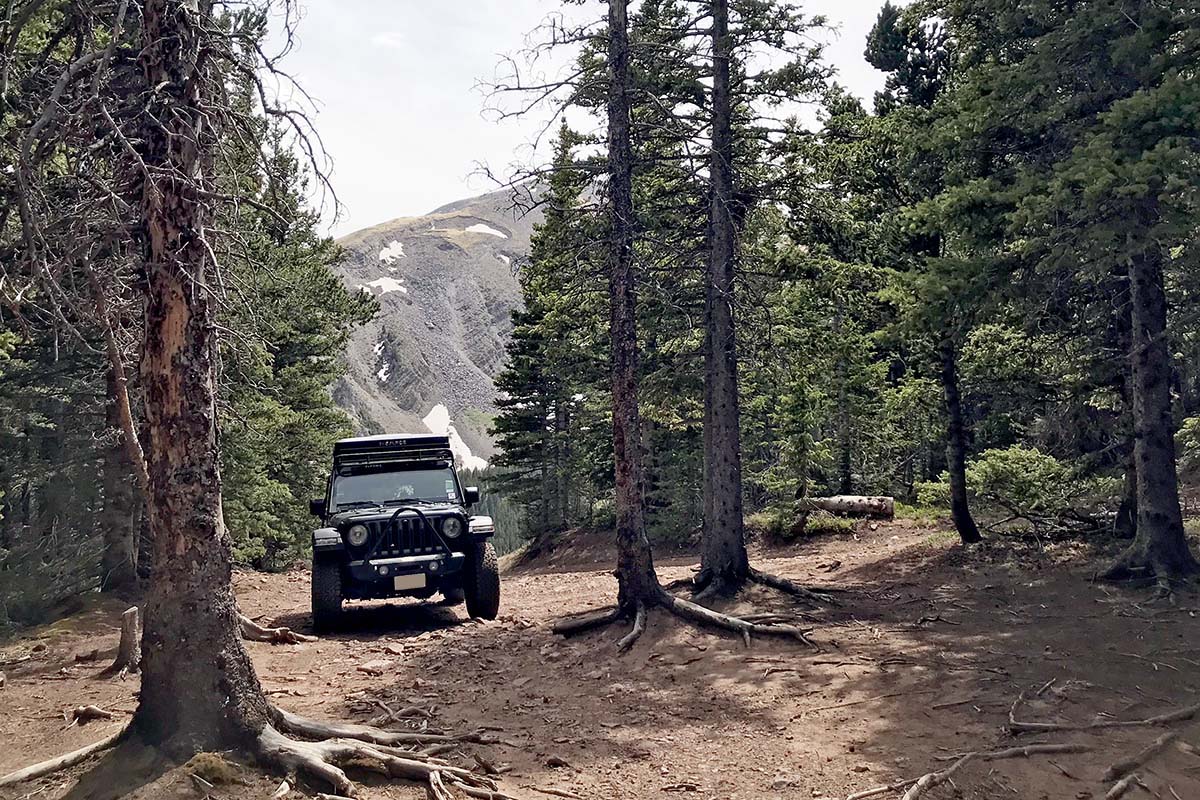
Weight
Without a doubt, rooftop tents are heavy and bulky pieces of gear. On our list above, weight ranges from 93 pounds for the "minimalist" Front Runner Roof Top Tent to a whopping 225 pounds for the gargantuan CVT Denali Pioneer (with extended fly). Because of their heft and bulk, these tents are not easy to install or take off, and generally will take at least two people to mount or remove from your vehicle.
However, the most important reason to consider weight has to do with your vehicle's handling and hauling capabilities. All vehicles have a rooftop load limit specified by the manufacturer (most cars and SUVs max out at 160 lbs.), which we recommend considering for a few reasons. A top-heavy load drastically affects your vehicle's center of balance, and overloading your suspension can have lasting implications. Further, gas mileage will suffer with a heavier load. And the load limit is especially important to keep in mind if you're planning on putting gear on top of your tent, as you might with the Roofnest Sparrow Adventure or iKamper X-Cover 2.0. In the end, we advise looking closely at these specs before buying—you'll want to be clear on your vehicle's rooftop capacity (both static and dynamic) and remember to also factor in the weight of the rack, your bedding, and any additional gear.
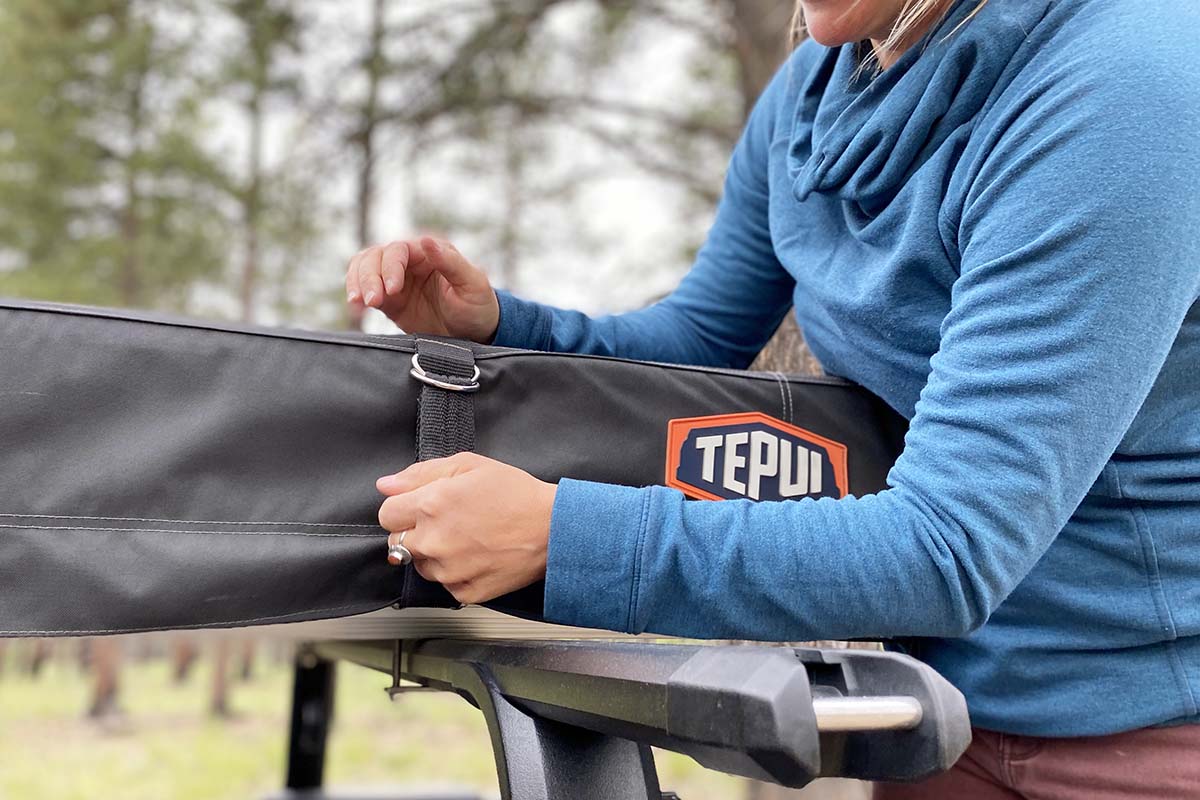
Features and Accessories
Most rooftop tents come with a fairly standard feature set that includes an aluminum ladder (sliding or telescoping), window awnings, and a hanging gear hammock. But premium models don't stop there. For example, the Summit series from Cascadia Vehicle Tents sports LED lighting, USB ports, and shoe bags. Verging on luxury, James Baroud's offerings include a solar-powered ventilation fan complete with air vents and dust filters. If you stick with the base models, you still have the option of tacking on extra items to your purchase. Rooftop tent brands like Thule Tepui and iKamper, for instance, sell additions like shoe racks, sheet sets, anti-condensation mats, inner insulation tents, and even retrofit canopy windows.
Annexes and Awnings
For those camping for extended periods, an annex or awning is a great way to increase livable space while maintaining privacy and protection from the elements, including sun, rain, and bugs. Annexes attach to the tent's extended platform and create an enclosed area underneath, which can be a great place for a portable shower or toilet, camp kitchen, or additional living space. The majority of annexes also enclose the ladder, creating a nice downstairs/upstairs feel. Awnings, on the other hand, are simple roofs that extend out from your tent and prop up with poles to create an open area that provides shade and additional coverage.
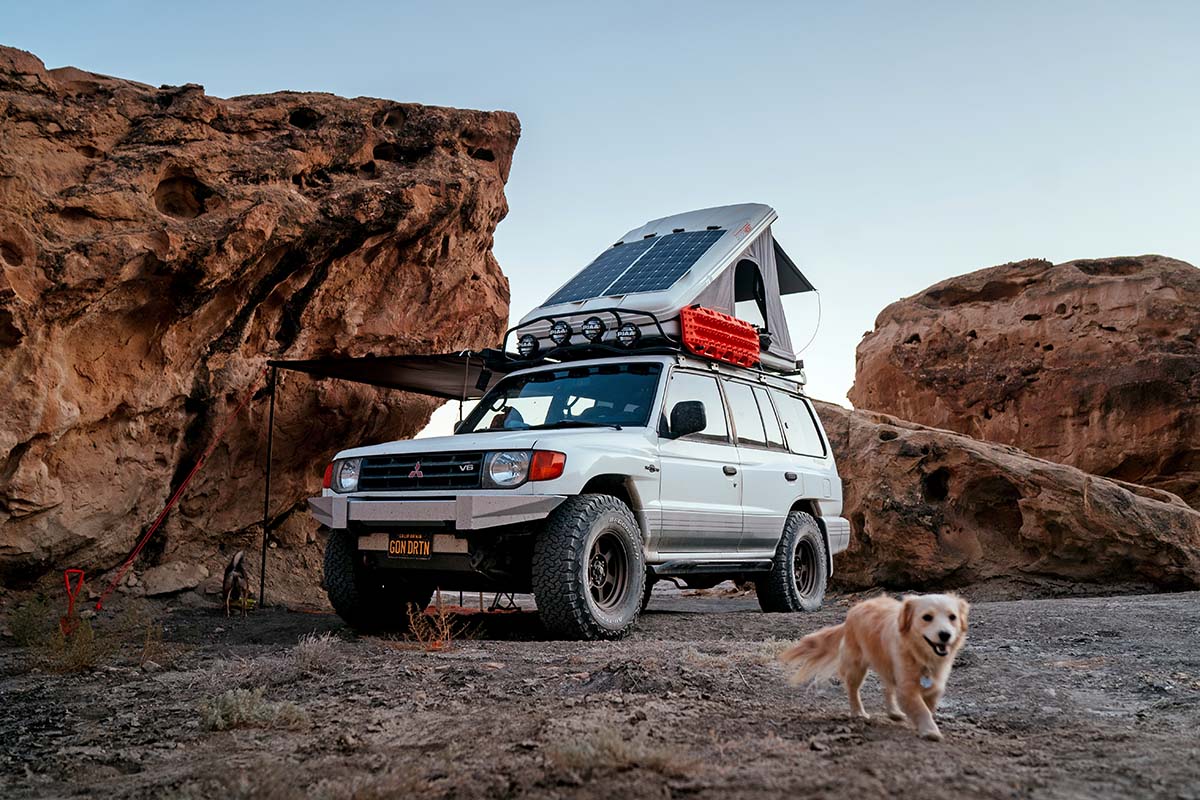
Some annexes or awnings come with the purchase of a tent (the CVT Denali Pioneer Extended, for example, includes an annex), but most are sold separately. If you're purchasing your tent and annex separately, you'll want to make sure they're compatible. Most share the same name to make things easier, and manufacturers also typically list which tents are compatible with which accessories. Finally, it's important to keep in mind that annexes cannot be paired with pop-up or clamshell tents that don't fold out beyond the footprint of your vehicle (with the exception of James Baroud's enclosed awning), so if you expect to add one later, make sure you're getting the appropriate style tent.
External Storage
If you like to bike, ski, paddle, or surf, you have a few different options for toting your extra gear along with a rooftop tent. First off is the Thule Tepui Foothill, which measures just 24 inches in width and leaves approximately half of your rooftop available for standard racks and gear. If you want a bit more sleeping space (the Foothill is fairly limited at around 27 sq. ft. of floor area), you might consider a rooftop tent with external storage compatibility. There are a few hardshells that allow you to attach gear to their top, including the iKamper X-Cover 2.0 and Roofnest's Sparrow. The X-Cover even comes with integrated cross bars that are compatible with aftermarket racks, while the Sparrow has a designated area for a solar panel (attached via Velcro) and comes with attachment points for an included waterproof cargo bag. And we'd be remiss not to mention Thule's Basin here, which is a pop-up hardshell designed with a removable mattress and zip-off fabric walls that allow it to double as a cargo box for gear storage. In other words, no need to alternate between mounting your tent or cargo box on your car each weekend.
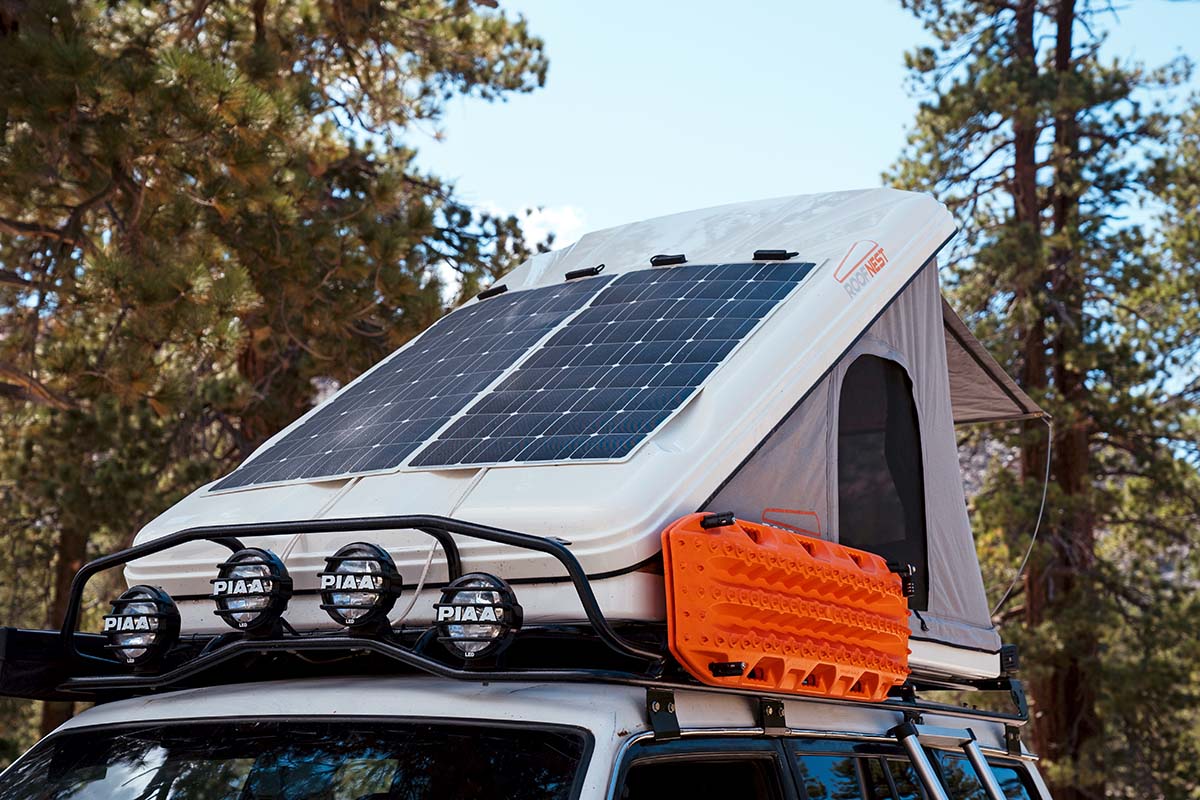
Durability and Maintenance
In general, rooftop tents are constructed with burly materials that can withstand frequent use and abuse. Concessions rarely are made for weight savings—expect to find ultra-thick fabrics and robust zippers (for example, Thule Tepui's Explorer Kukenam 3 has 600-denier walls compared to the 75D fly fabric on a popular camping tent like the REI Co-op Kingdom). In addition to fabrics, the metal components are built to last, and the floors are designed to handle serious weight.
Despite the impressive overall build quality, the biggest threat to rooftop tents is exposure. Unless you're removing your tent from the roof of your vehicle between each outing, it's bound to suffer sun and moisture damage over time. Hardshells fare much better, with secure waterproof shells that last longer and stand up to the elements more than the canvas or nylon covering on softshells. That said, not all softshells are created equal. The Thule Tepui Explorer Kukenam, for example, uses UV- and mold-resistant fabric to increase its lifespan, and Thule Tepui also has a dedicated lineup of "Ruggedized" tents that are made with thicker fabrics (360 vs. 260g canvas), sealed seams, and a heavy-duty aluminum base to guard against branches and rocks. But if and when your softshell does need replacing, most models use zippers to attach the tent canopy to the frame, so you can replace the canopy without buying an entirely new set-up.
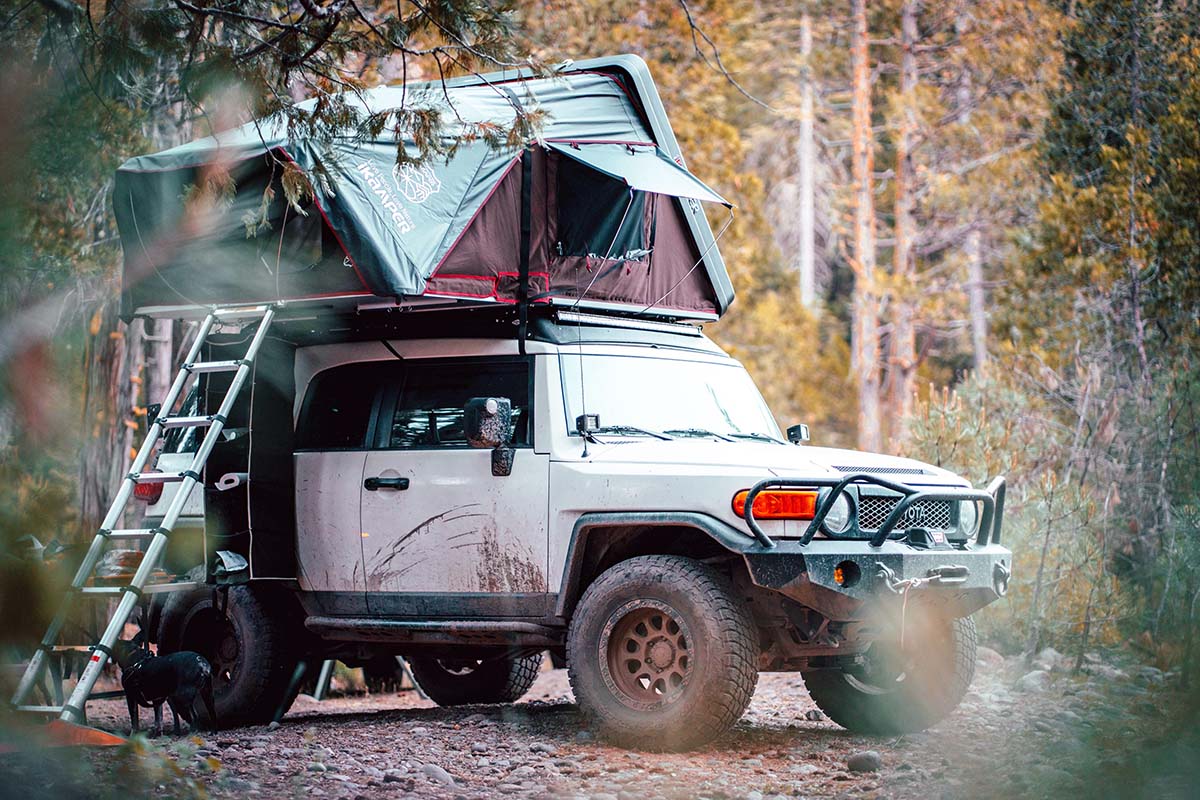
Regardless of the model you choose, there are steps you can take to extend the life of your tent. Most importantly, you'll want to make sure the tent is fully dried out after each trip and store it in a dry, shaded area, just as you would with a standard tent. We also recommend regularly propping up the mattress so that the base of the tent has a chance to air out. If grime gets into the fabrics or zippers, it can degrade them quickly, so routine cleaning using mild dish detergent and warm water is a good idea. Finally, if your rainfly or tent walls stop repelling water and you need to revive the waterproofing, we've found that a marine-grade spray-on protector like Star Brite's Waterproofing Spray works best.
Vehicle and Rack Compatibility
Before you purchase a rooftop tent, you'll want to be sure you have the right vehicle for the job. In general, if your car, truck, SUV, or van can be paired with a roof rack, chances are you'll be able to attach a rooftop tent. Some vehicles come with factory roof racks already installed, but many are aftermarket additions from companies like Thule and Yakima. The first step is to purchase a rack that is compatible with your vehicle (many manufacturer websites makes this fairly simple with interactive fit tools, like Thule's Fit Guide here). Next, you'll want to be sure your rooftop tent fits the rack. The good news is that this is a lot less complicated than it sounds: most rooftop tents are highly adaptable and come with a range of adjustments and available adaptors.
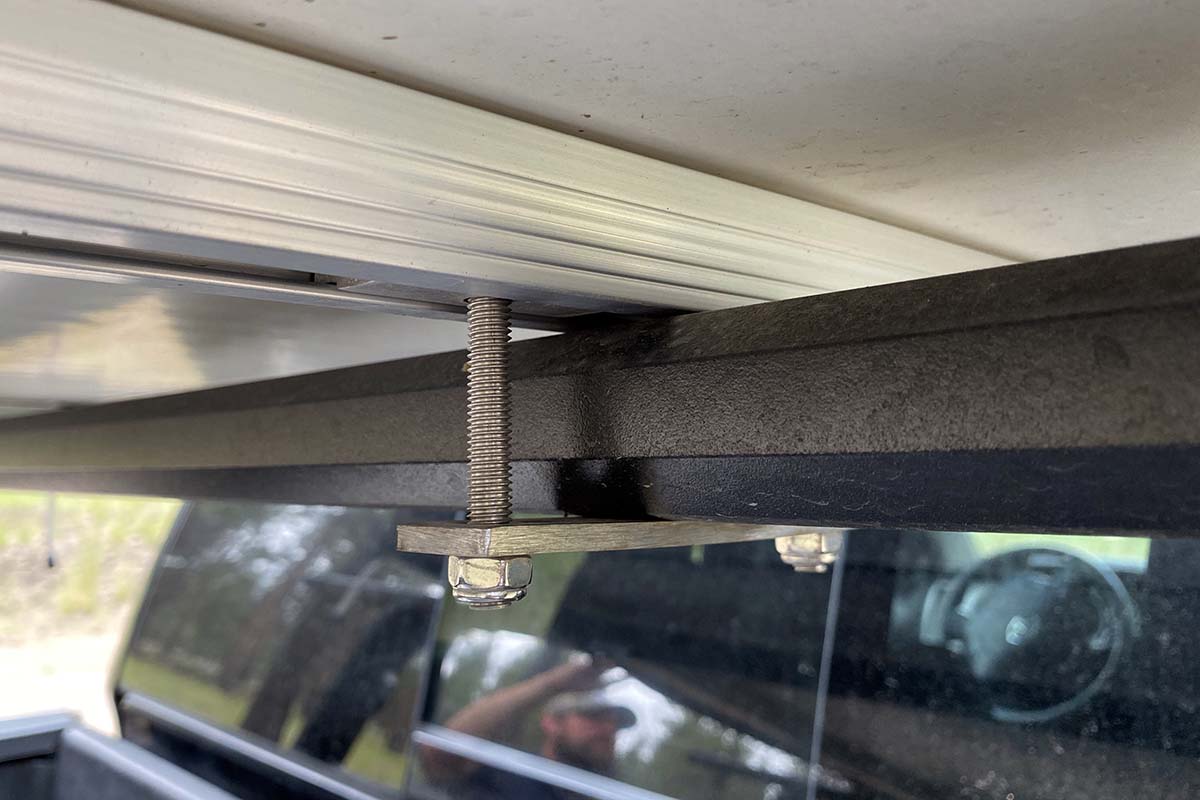
There are a few other factors to consider in regard to vehicle compatibility. As we mentioned above, all vehicles come with static and dynamic load ratings, which put a limit on the weight of your tent. If you have a car, small truck, or SUV, this is especially important to know beforehand (for example, the 225-pound CVT Denali Pioneer Extended can only be mounted on larger vehicles). You'll also want to think about mounting location: rooftop tents can be affixed to your roof, over your truck canopy or empty truck bed, on a trailer, or even on a hitch rack like the Rubicon EP Hitch Tent Rack System (this will free up your rooftop for other gear).
Installing a Rooftop Tent
Once you've made sure that your rooftop tent is compatible with both your vehicle and your rack, you're ready to load it on top (again, we recommend at least two people for the job). In our experience, the most user-friendly tents are those made by rack companies (Thule and Yakima in particular) that are compatible with specific racks—you can purchase the rack and tent at the same time and know you're getting a pair that works together. Other designs will require a bit more DIY savvy to install (YouTube videos are very helpful), and likely a few trips to the hardware store. Again, purchasing from a local gear shop will typically alleviate some of the headache, as many shops will be able to help load your tent onto your vehicle.
Purchasing a Rooftop Tent Online
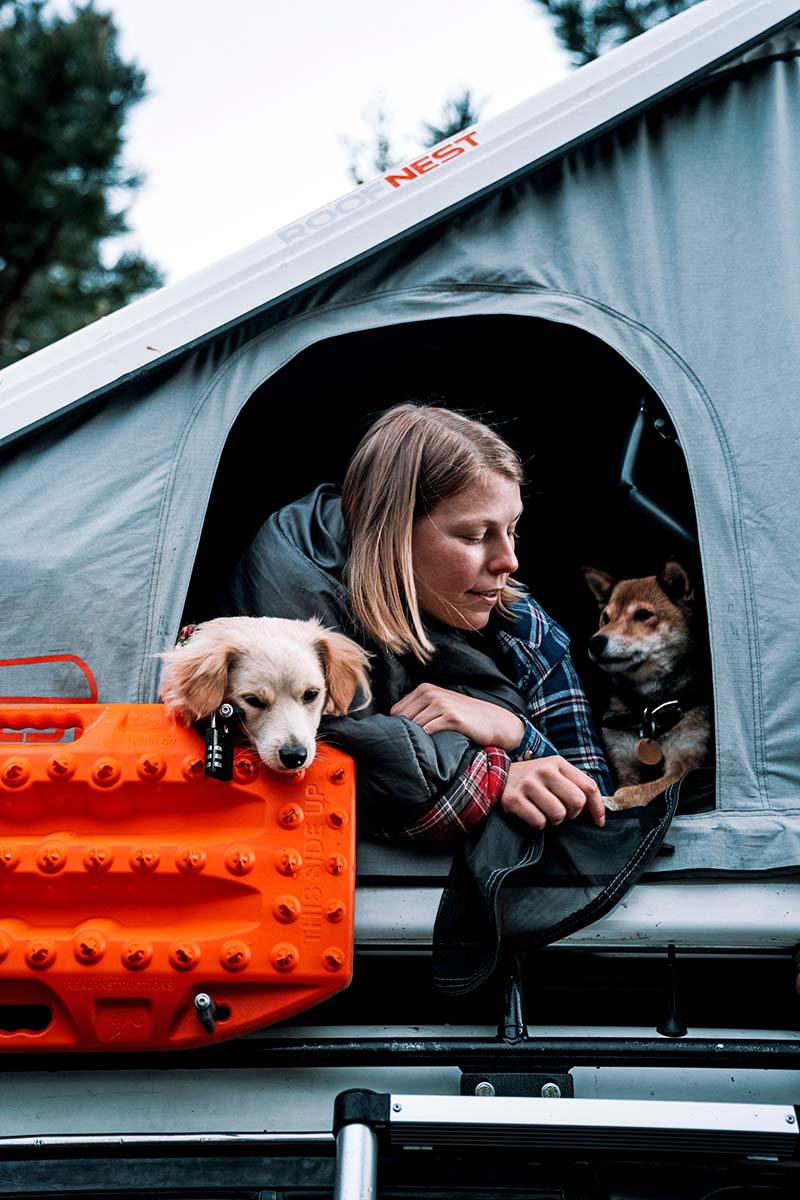
Given that rooftop tents are such large investments, we recommend going into your local retailer or gear shop and comparing various models before making a decision. Simply put, there's no substitute for being able to hop in a tent and get a feel for the overall build and dimensions. Most REI Co-op stores have a selection of Thule Tepui and iKamper tents, and you can also find models for sale at rack, vehicle accessory, or overlanding stores. Another advantage to shopping in person: there's a good chance most brick-and-mortar retailers offer installation services. But there's no denying the deals you can find online, and the most rooftop tents listed here can be purchased from the comfort of your home. Shipping fees might offset your savings (REI Co-op and Thule charge $160 and $150, respectively), but some retailers ship free of charge, including iKamper and Roofnest. If you know which model you want to buy and don't have to pay an arm and a leg for shipping, buying online isn't a bad idea.
Is a Rooftop Tent Right for You?
Not only do rooftop tents allow you to turn practically any vehicle into a camper and free up valuable storage space inside, but they're more comfortable than a standard camping tent, far easier to set up, and keep you off the ground. But before you make such a big investment, it's important to consider the downsides: rooftop tents are expensive, will impact gas mileage and handling of your vehicle, and are heavy pieces of gear that are onerous to move around. Further, unlike a ground tent, you'll have to pack up camp every time you choose to move your vehicle, and getting in and out via ladders can get old quickly. In the end, it's important to evaluate your camping preferences and needs. If convenience and comfort are the biggest factors and you're less worried about the logistics of carrying it on your car, a rooftop tent makes a lot of sense.
Back to Our Top Rooftop Tent Picks Back to Our Rooftop Tent Comparison Table
Source: https://www.switchbacktravel.com/best-rooftop-tents
0 Response to "Easy Set Up and Take Down Car Tent"
Post a Comment